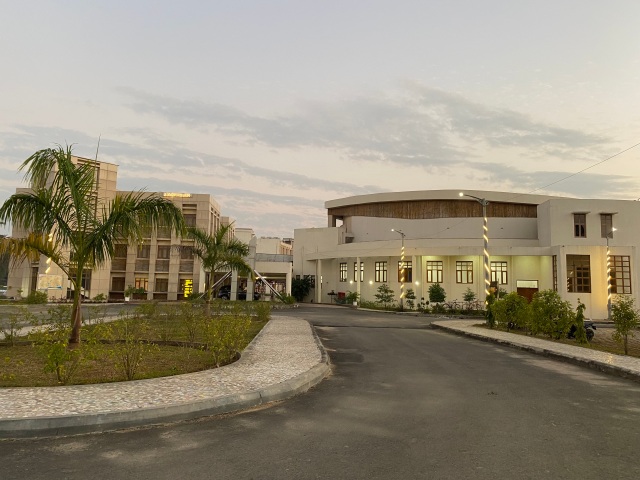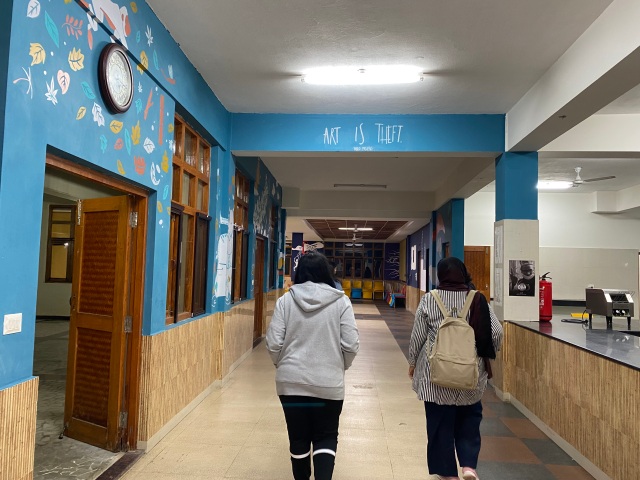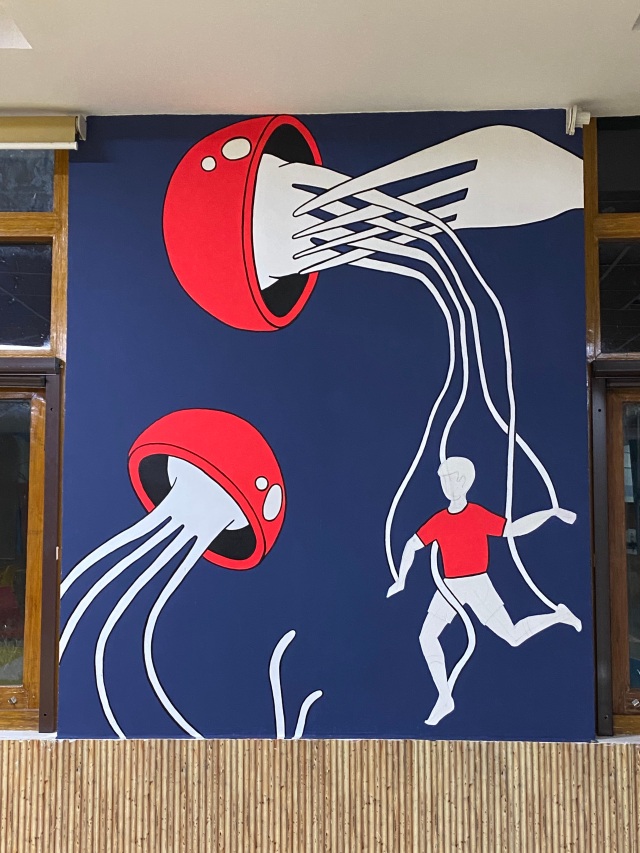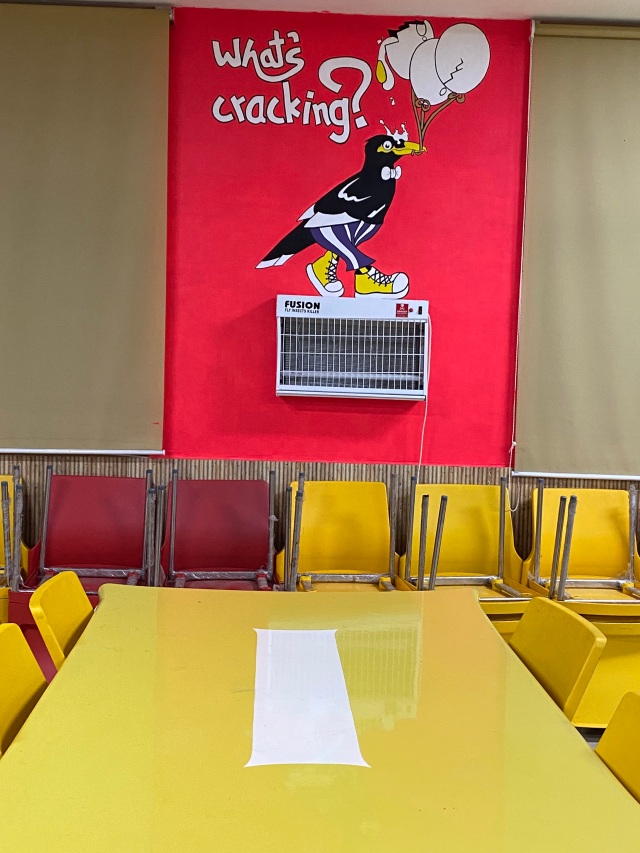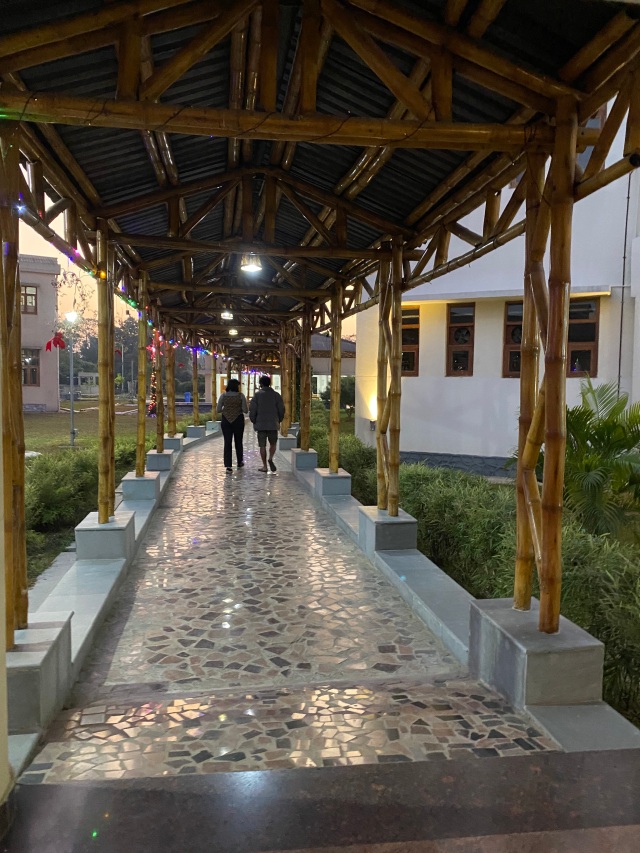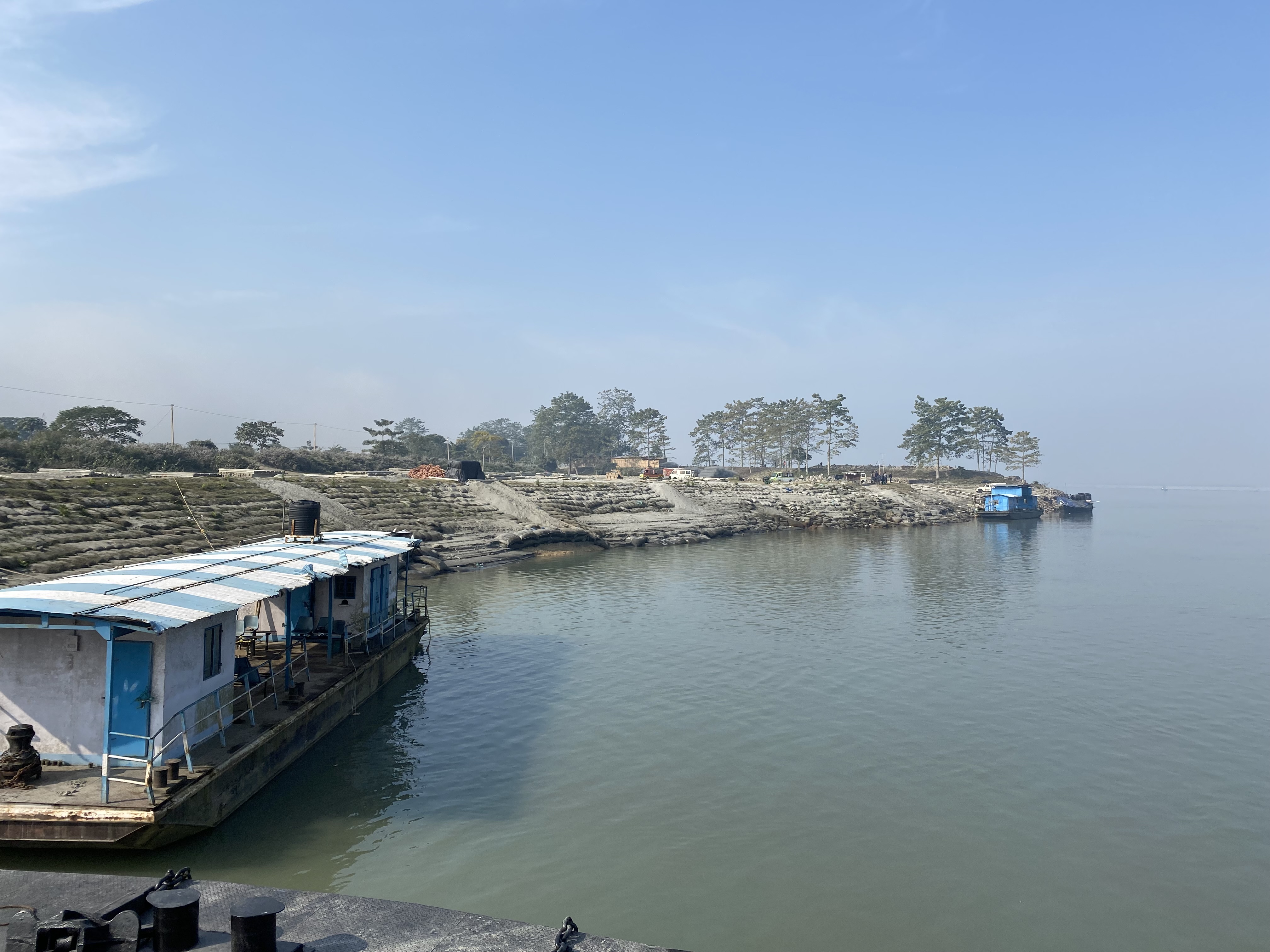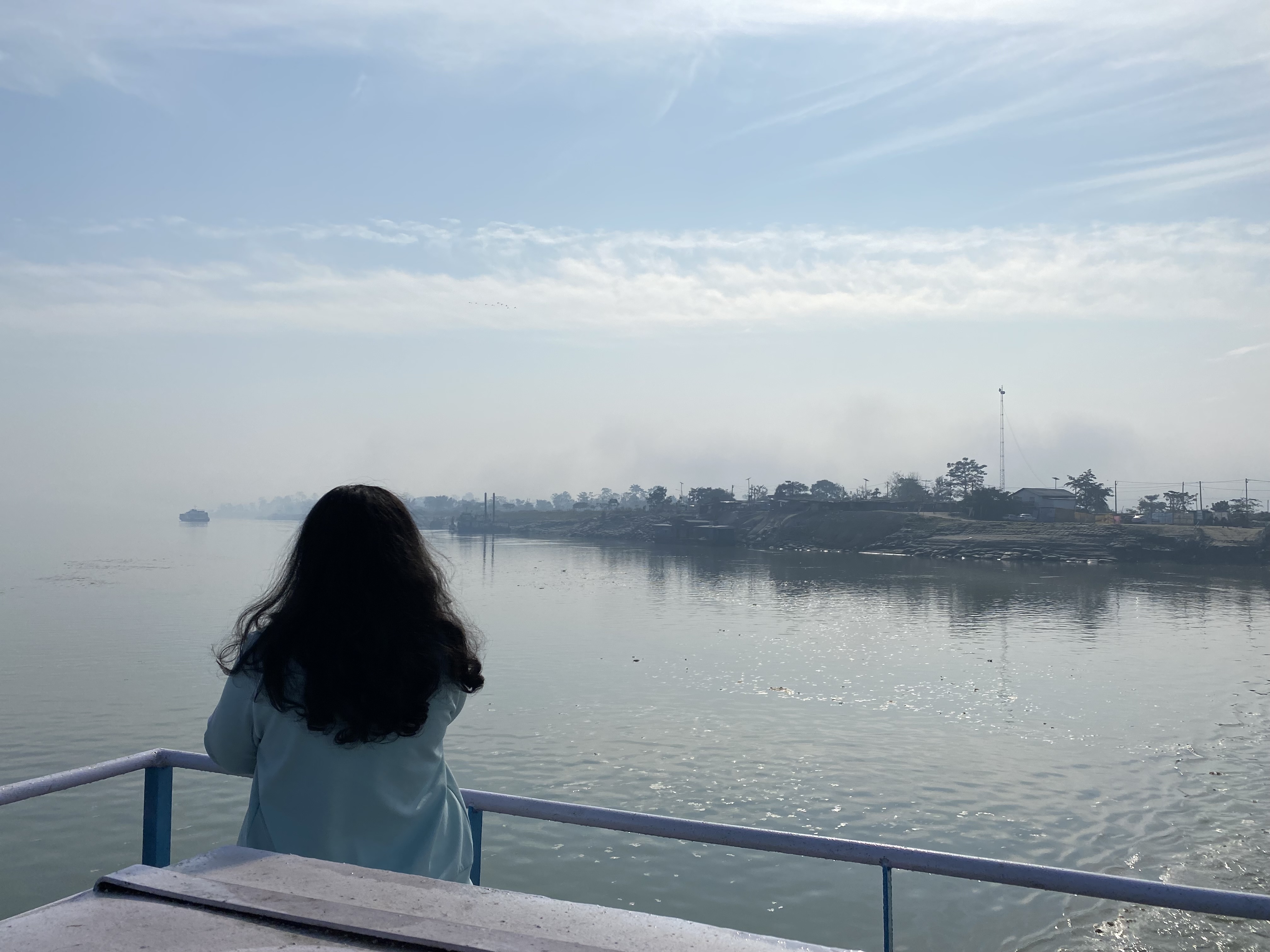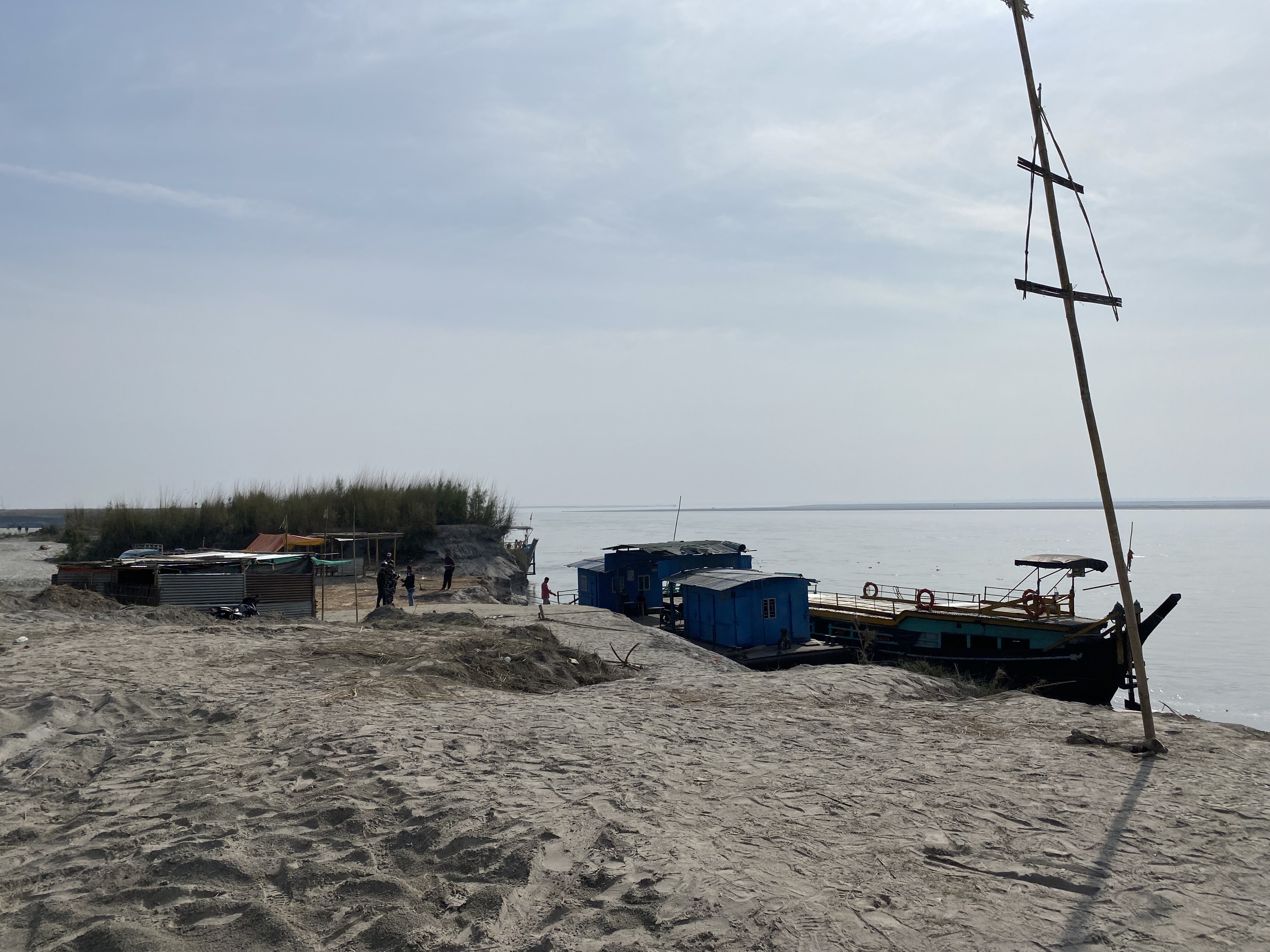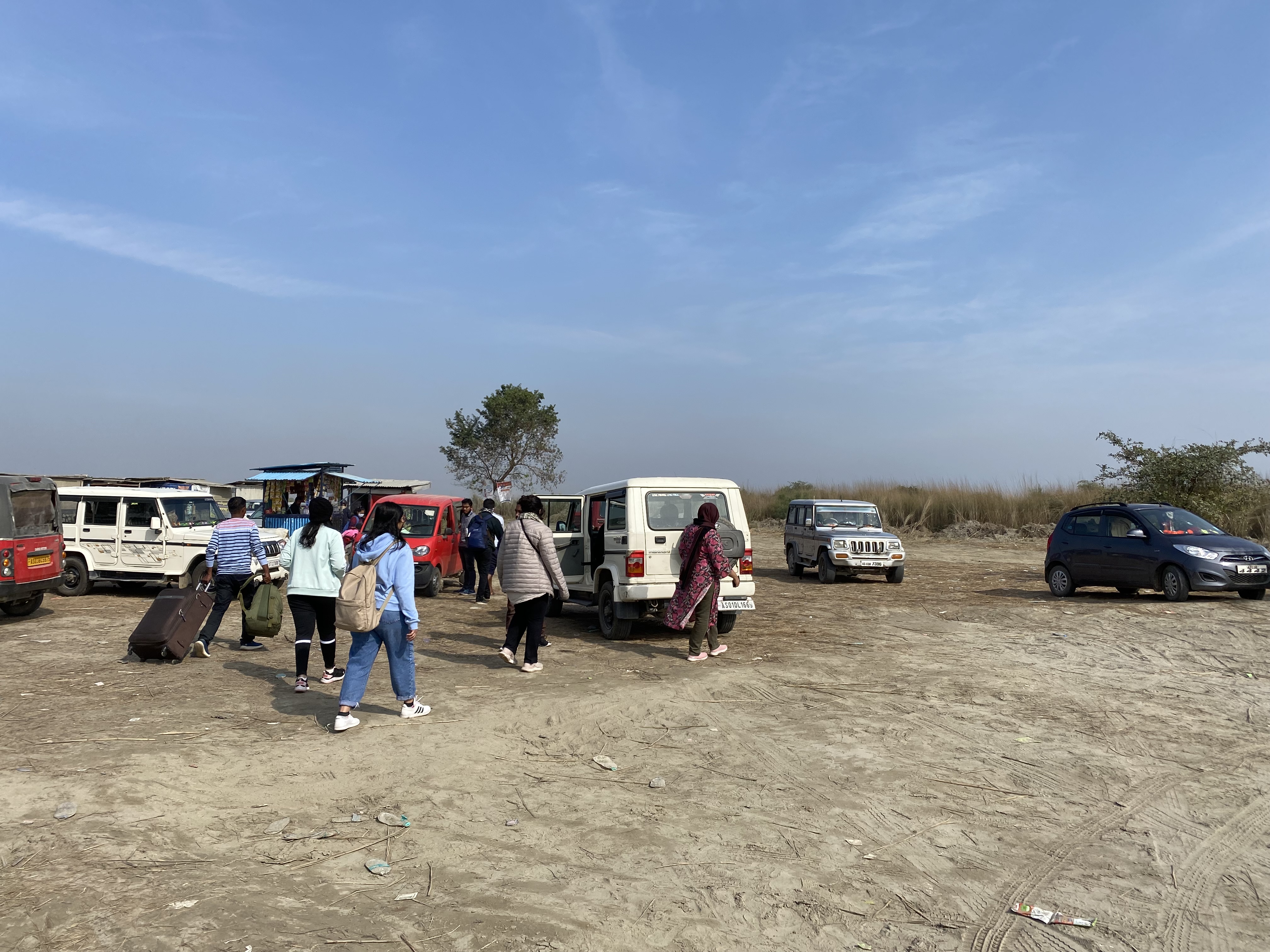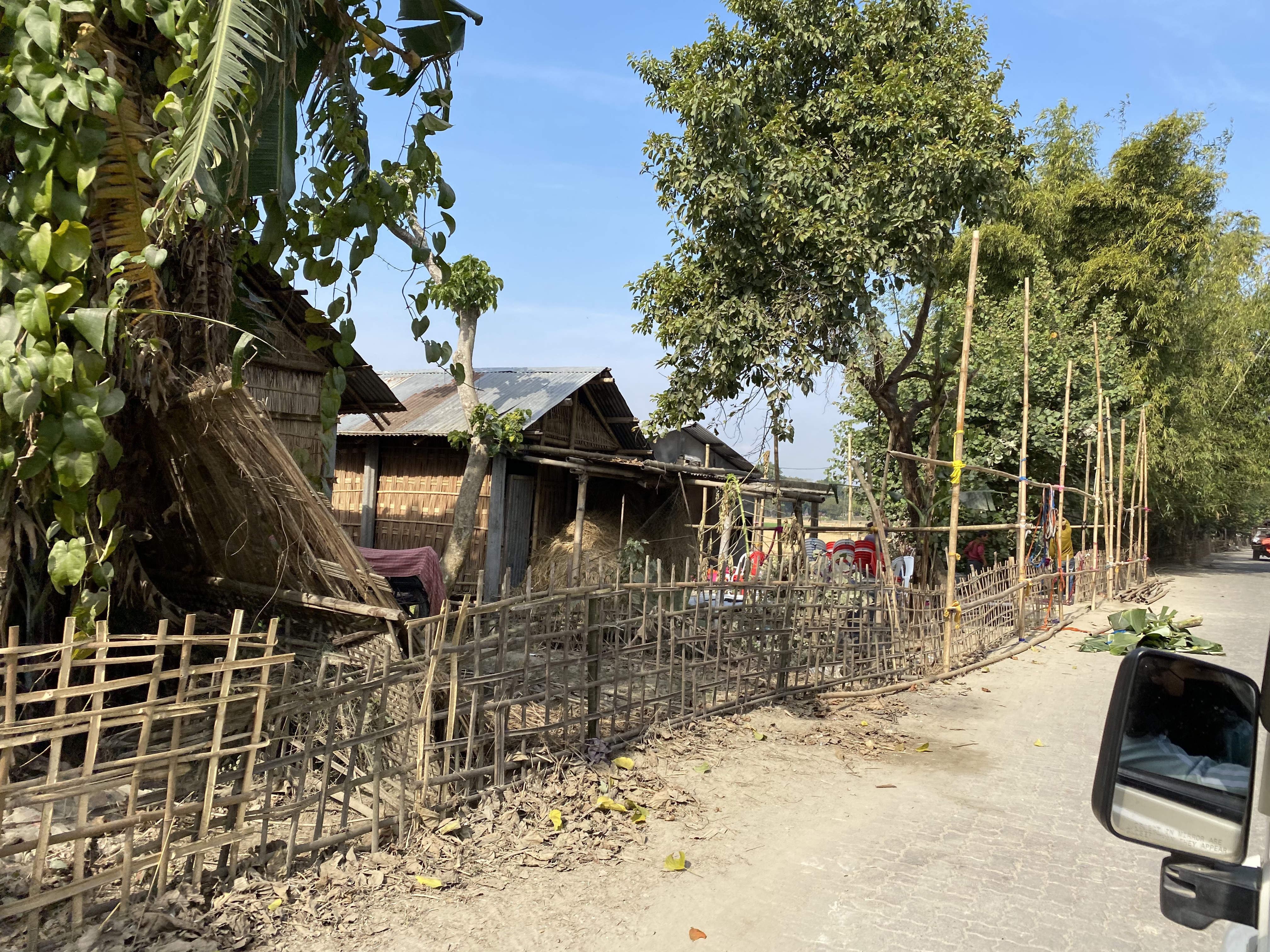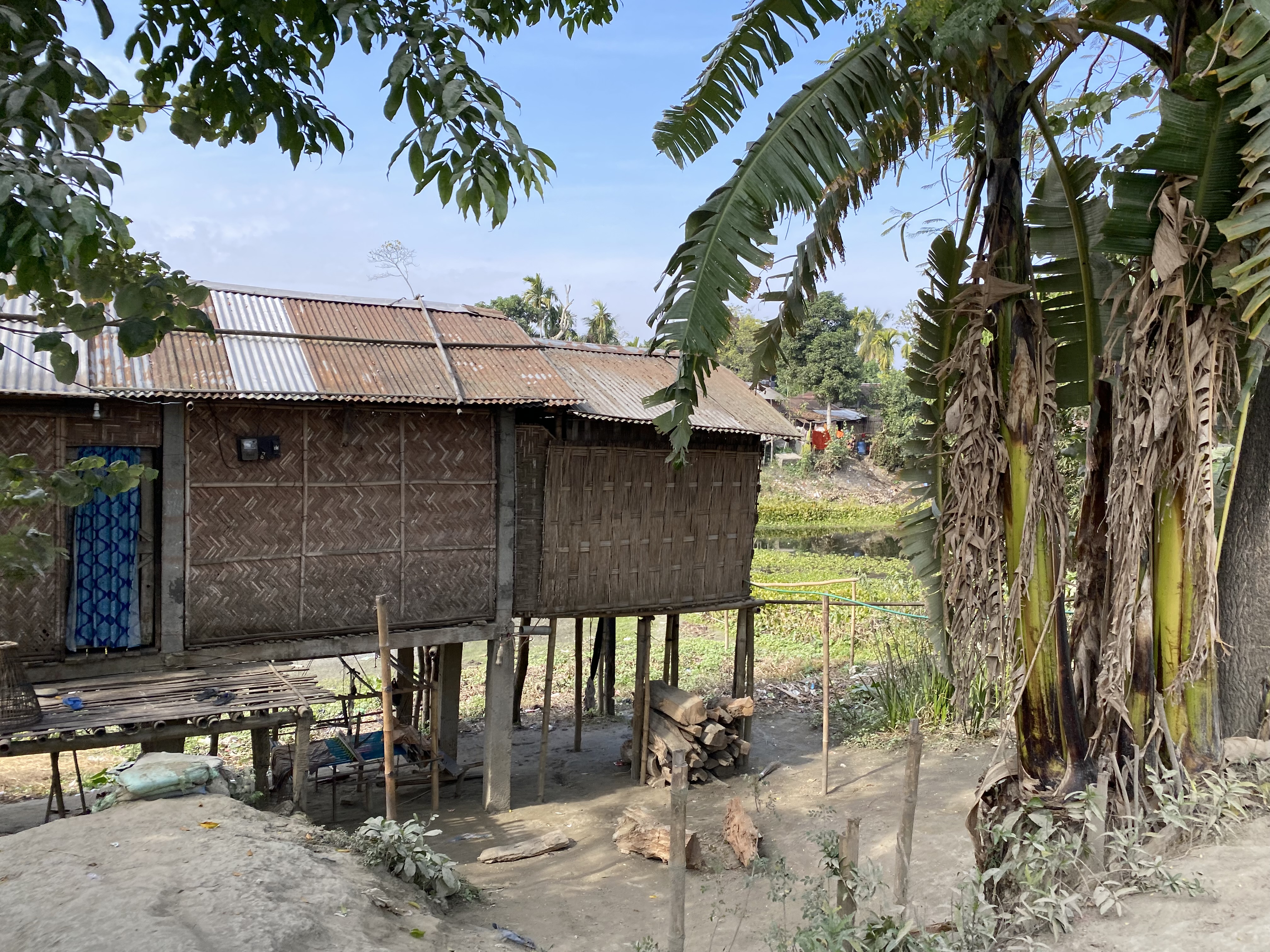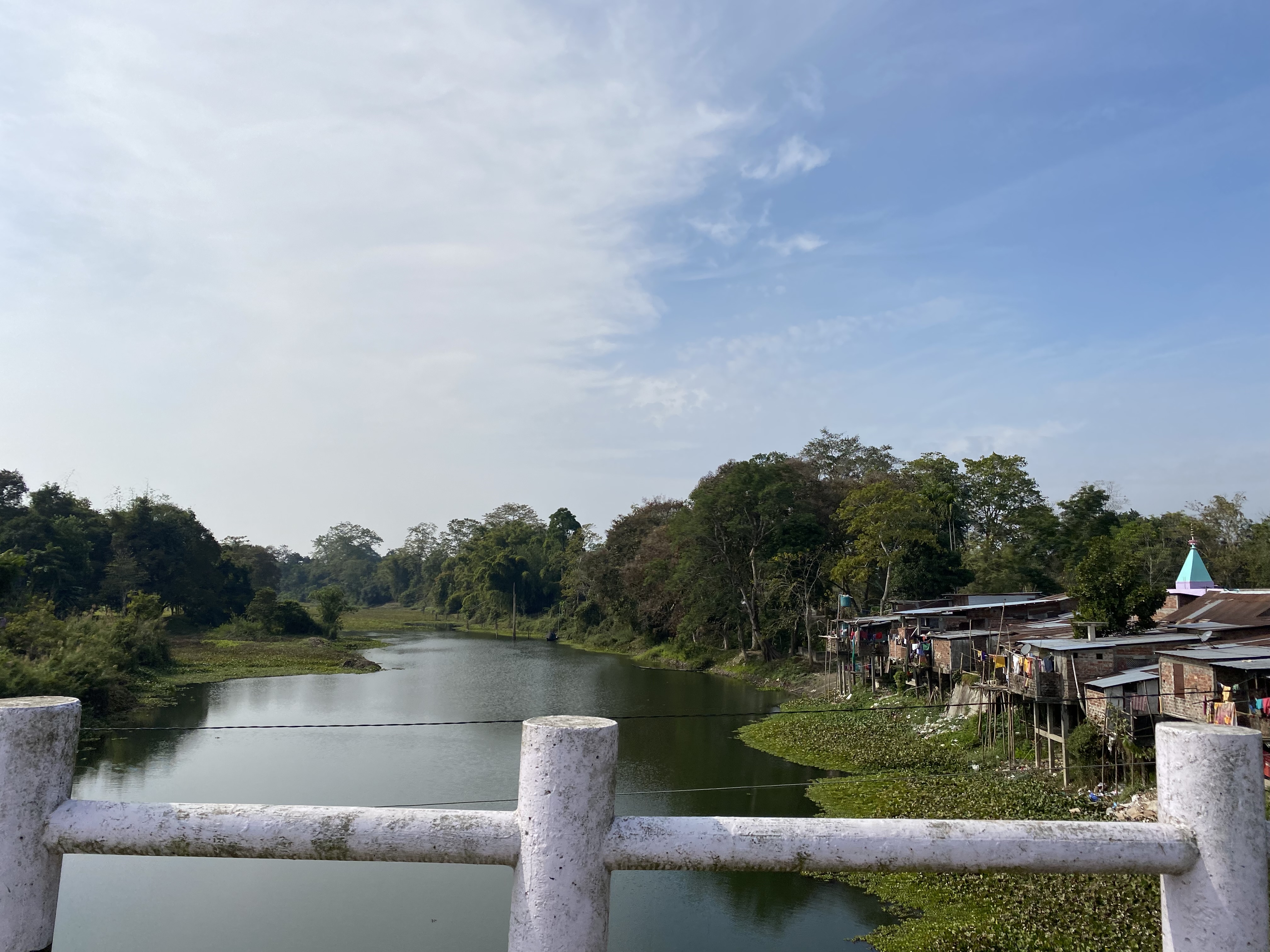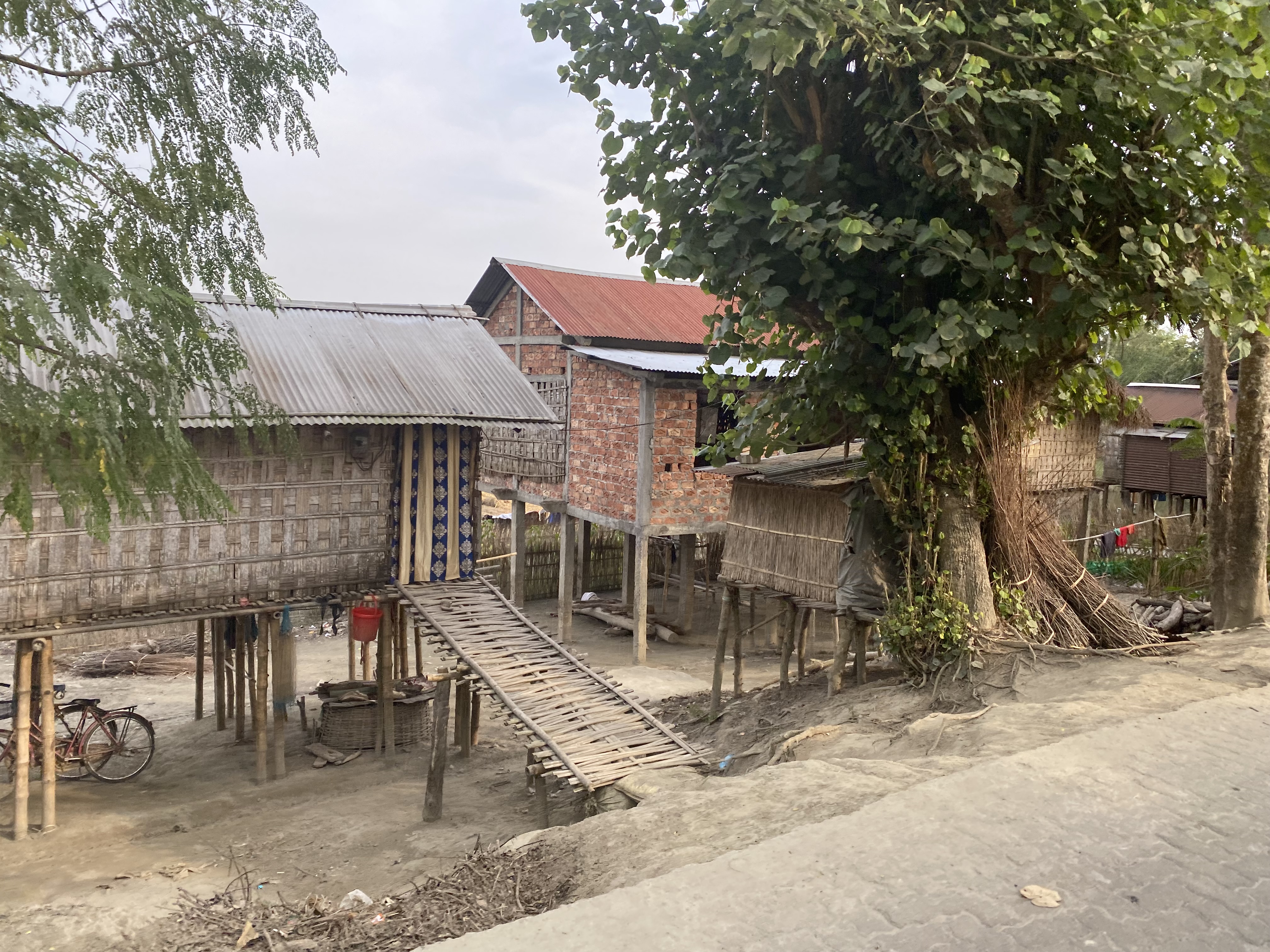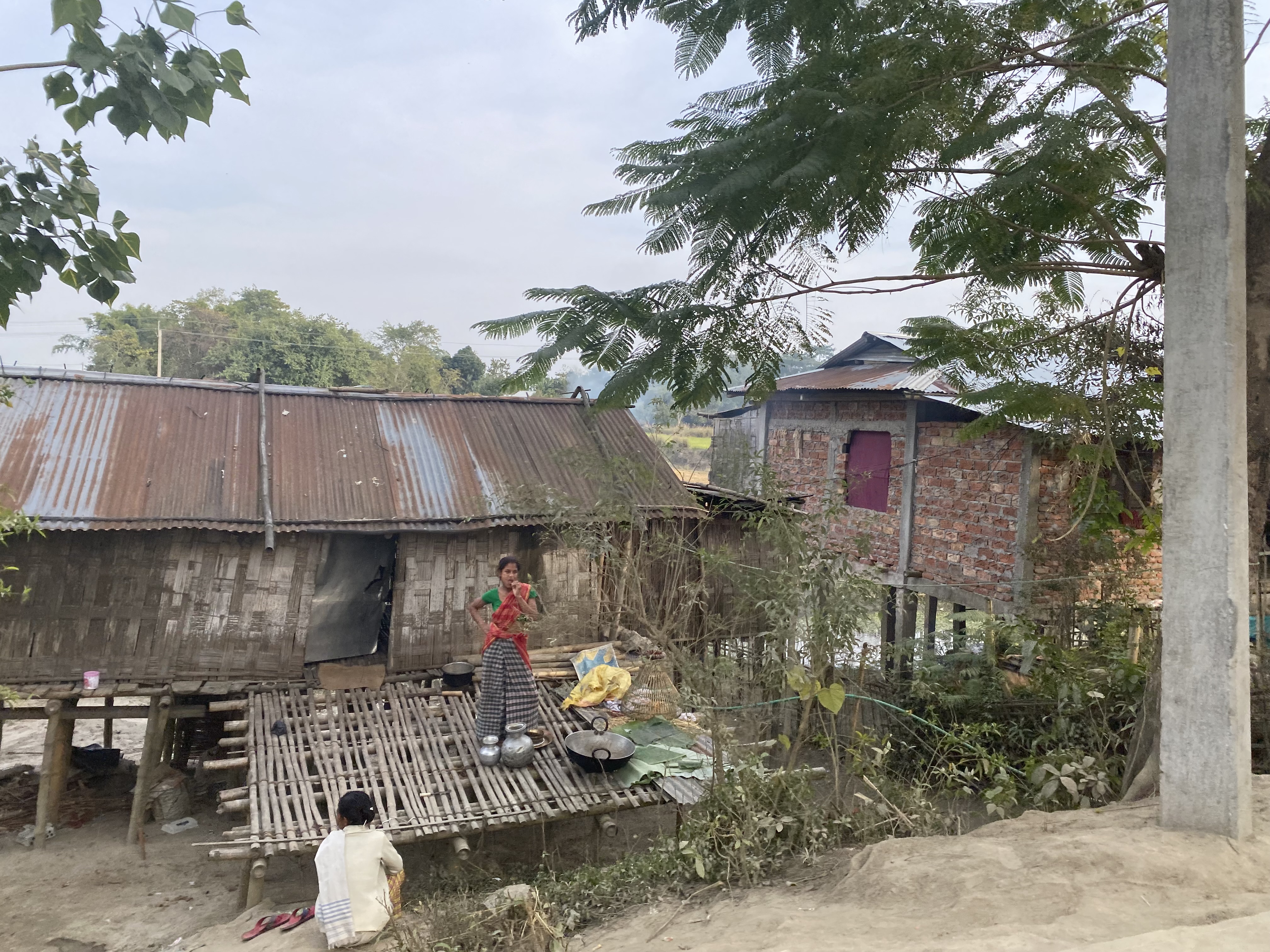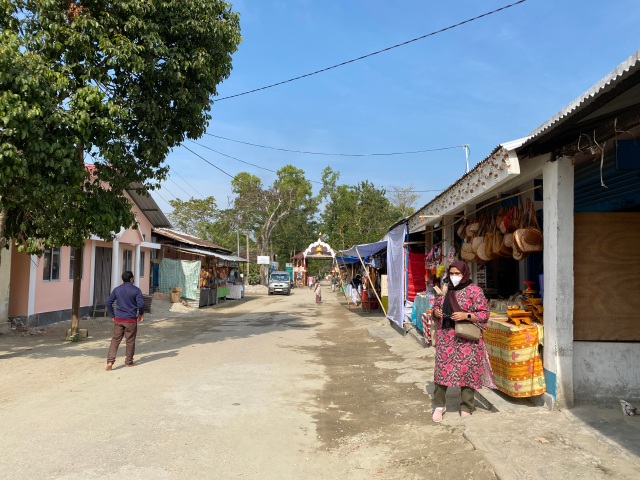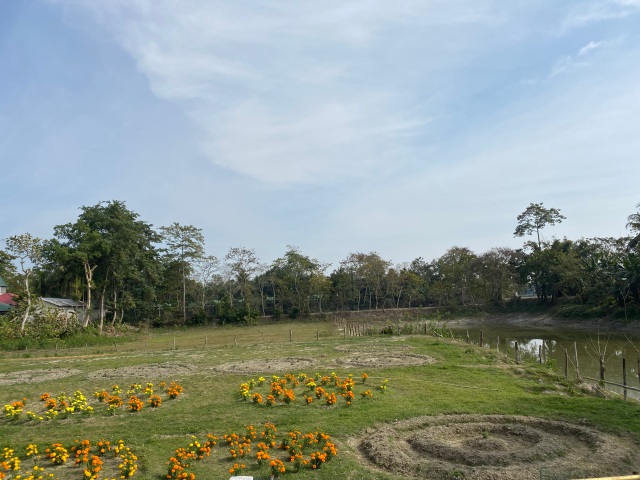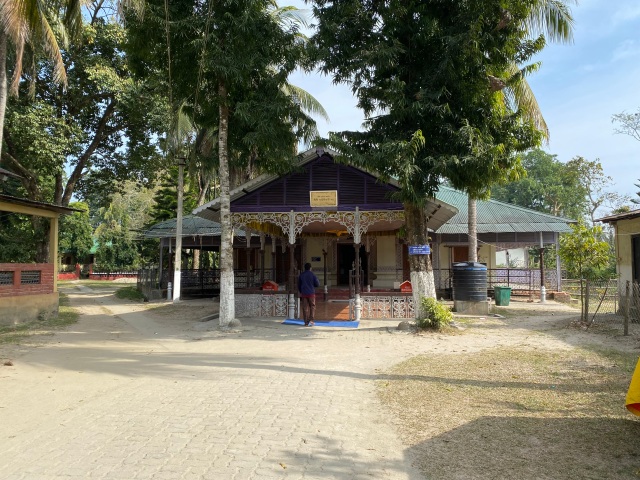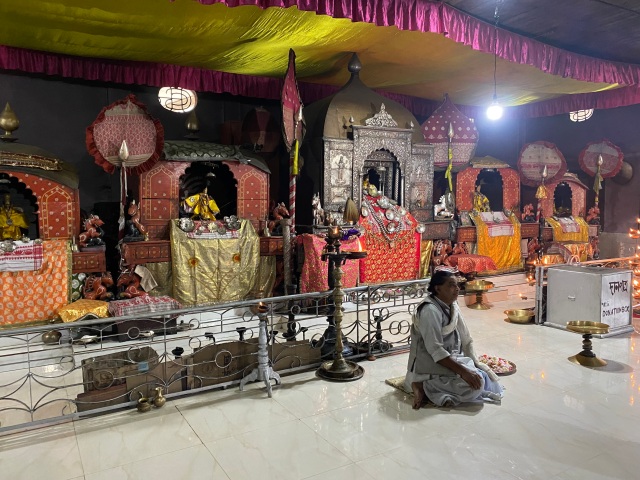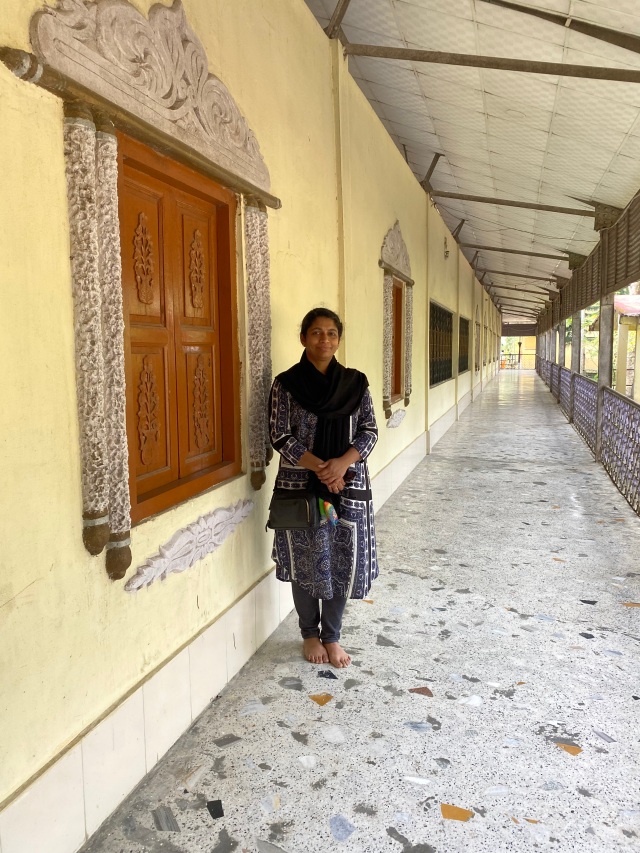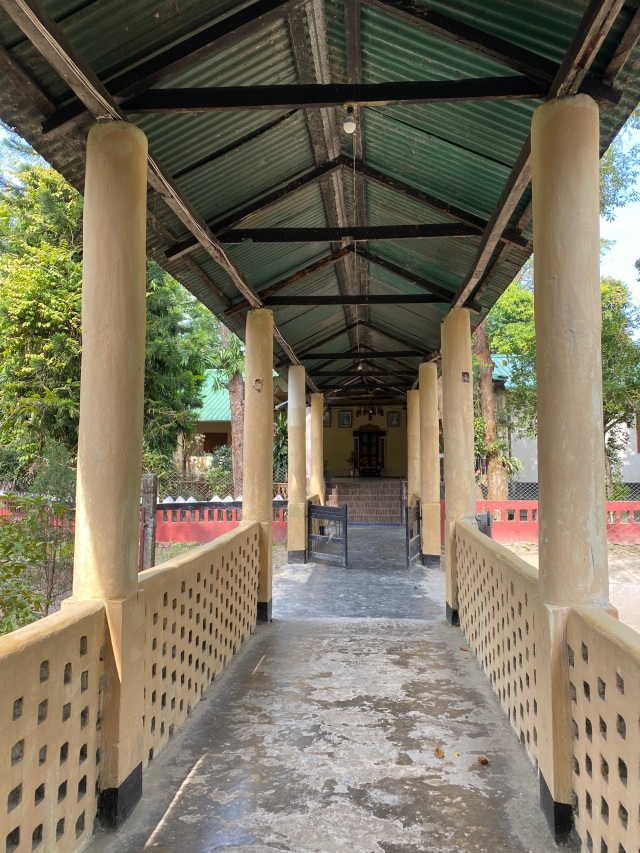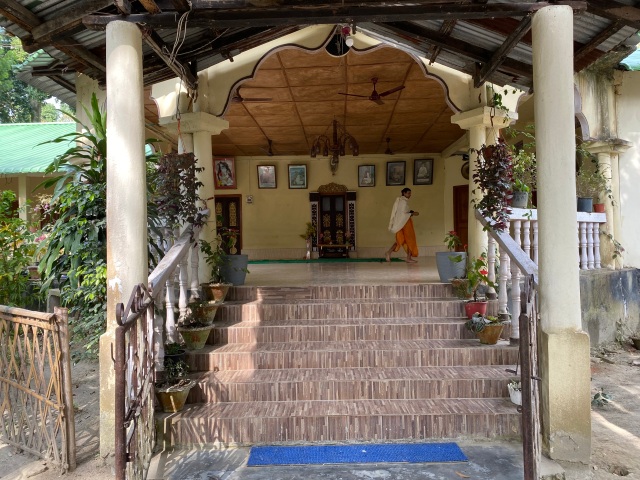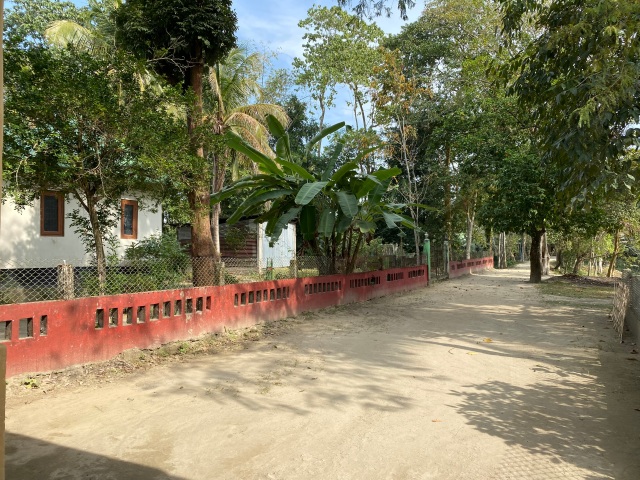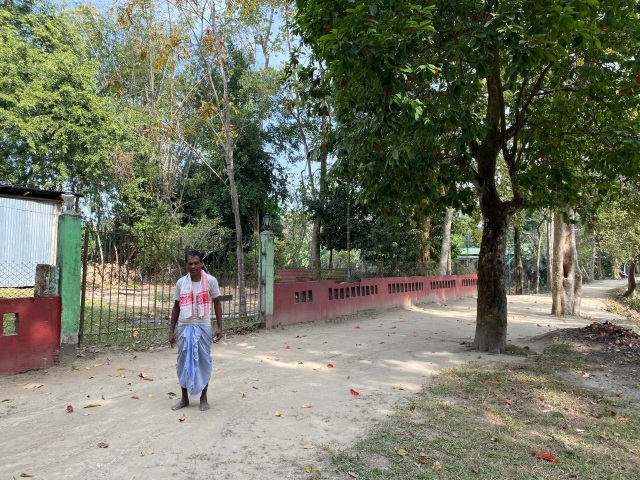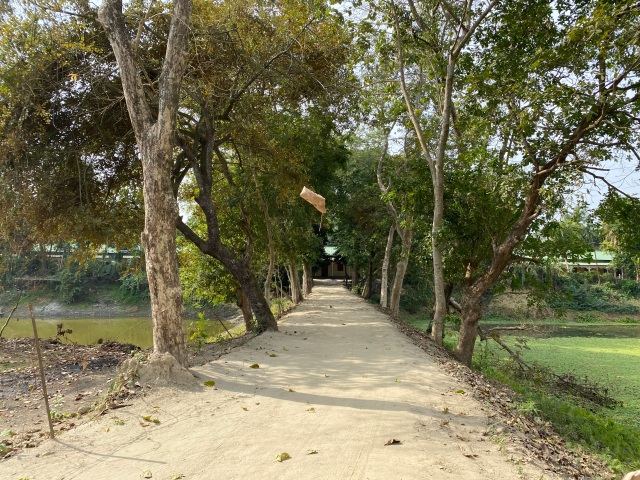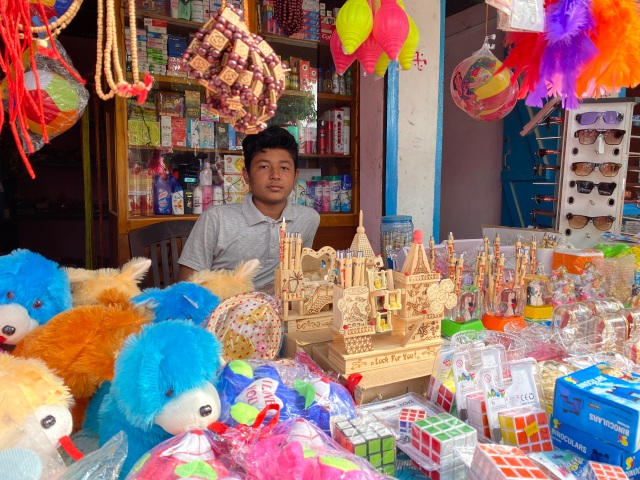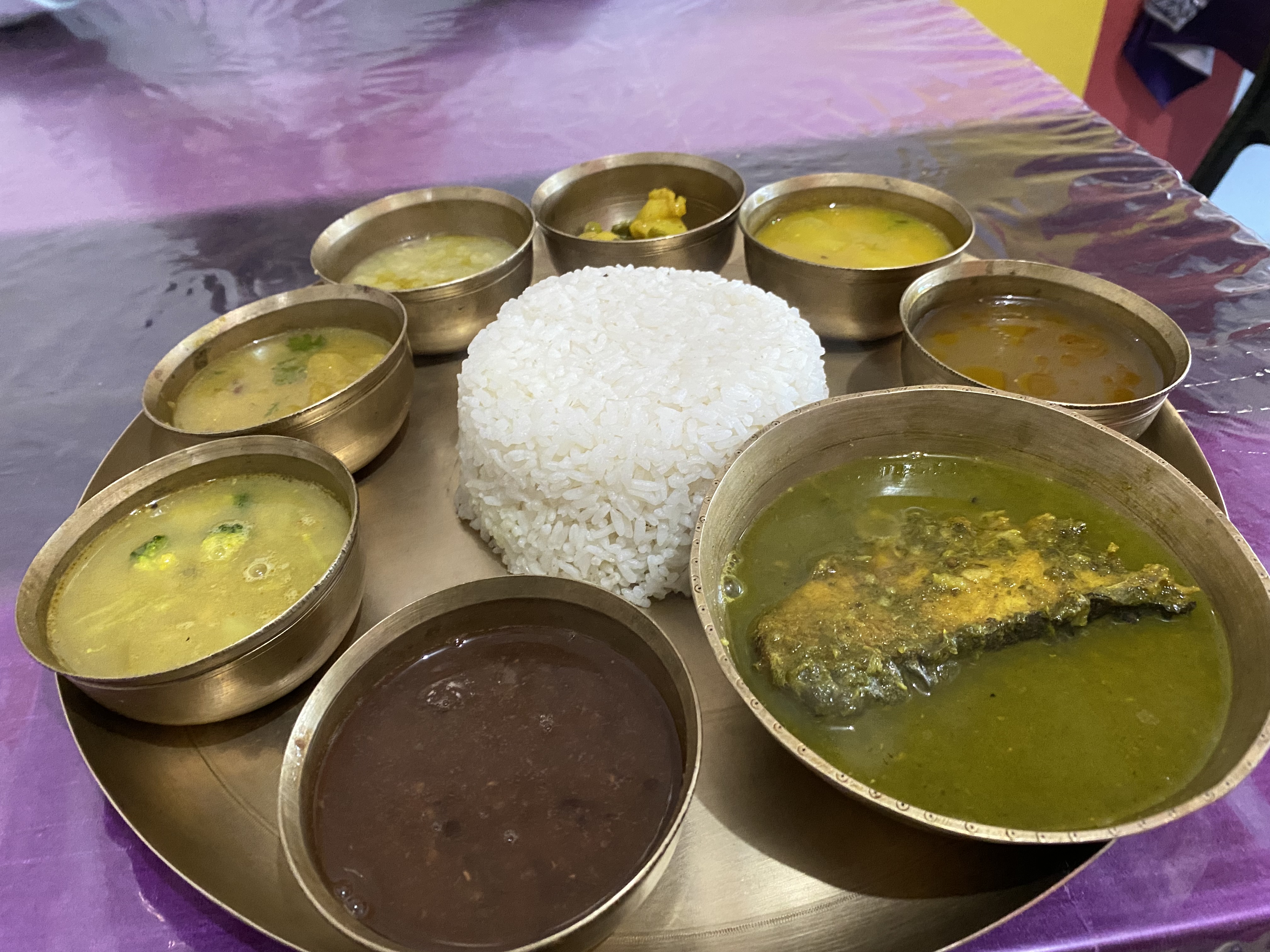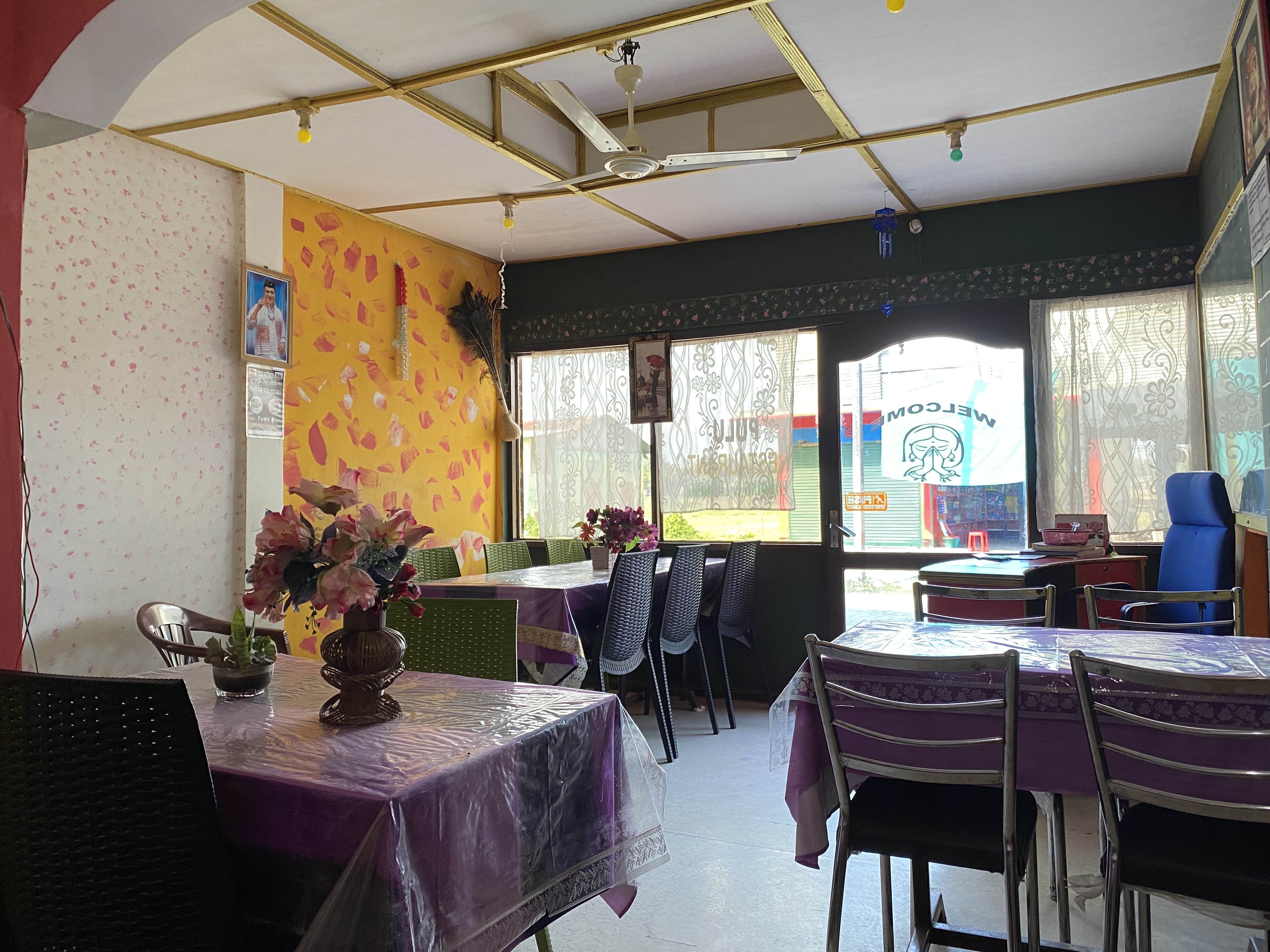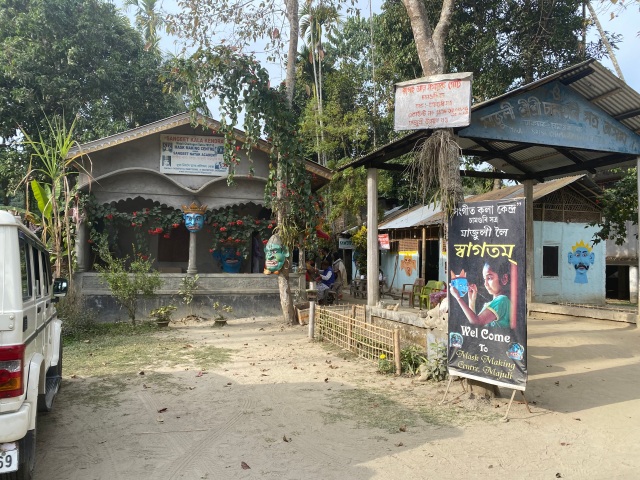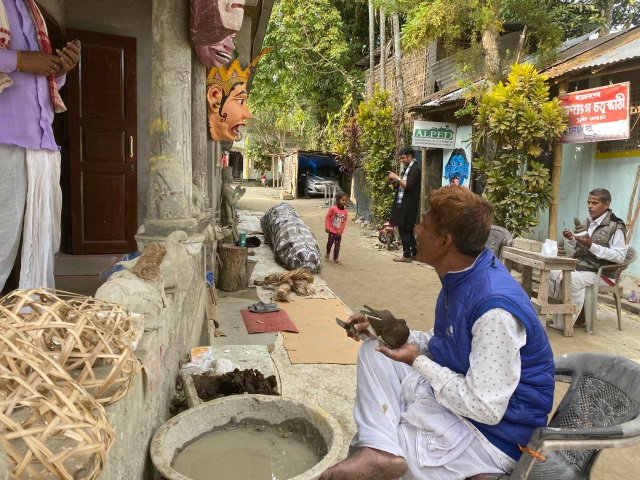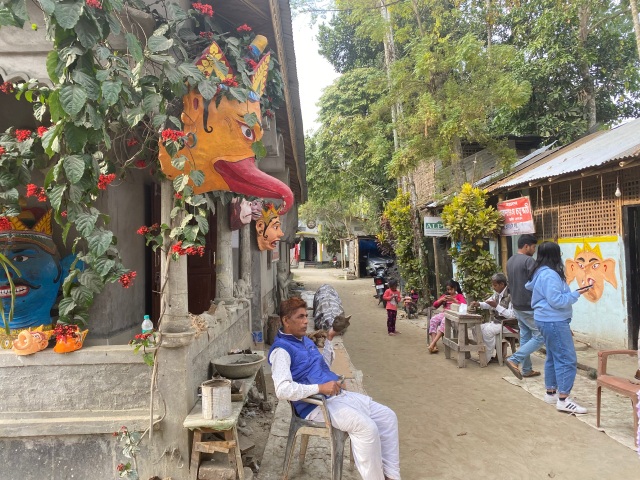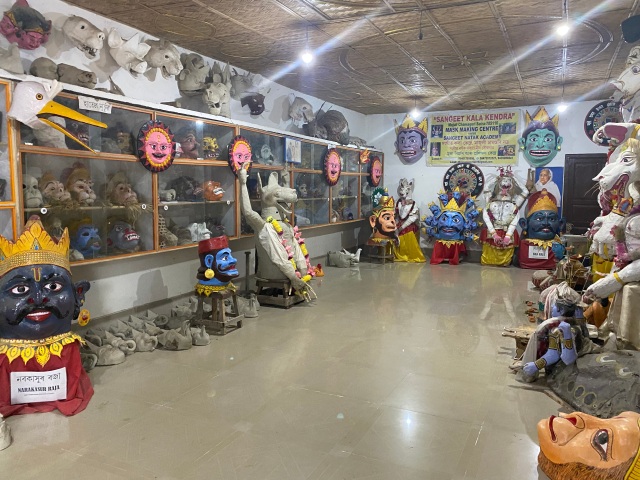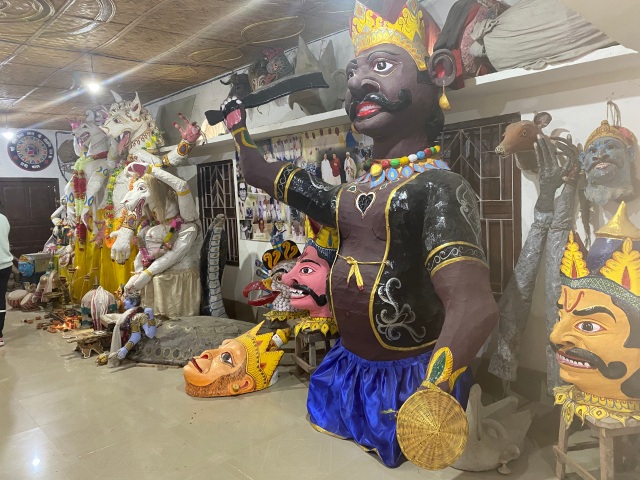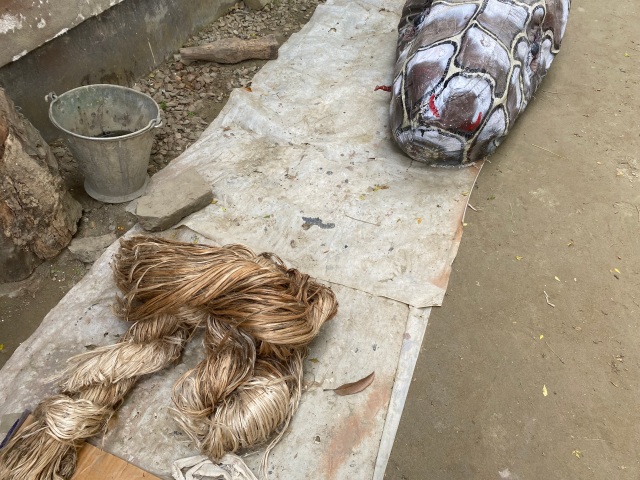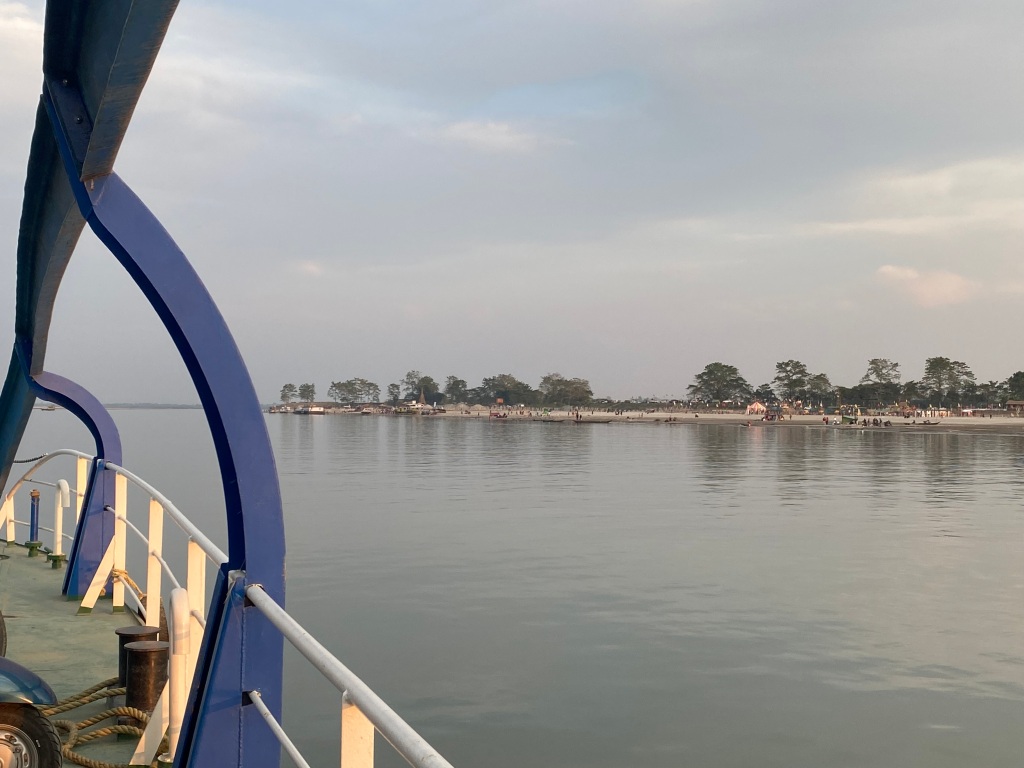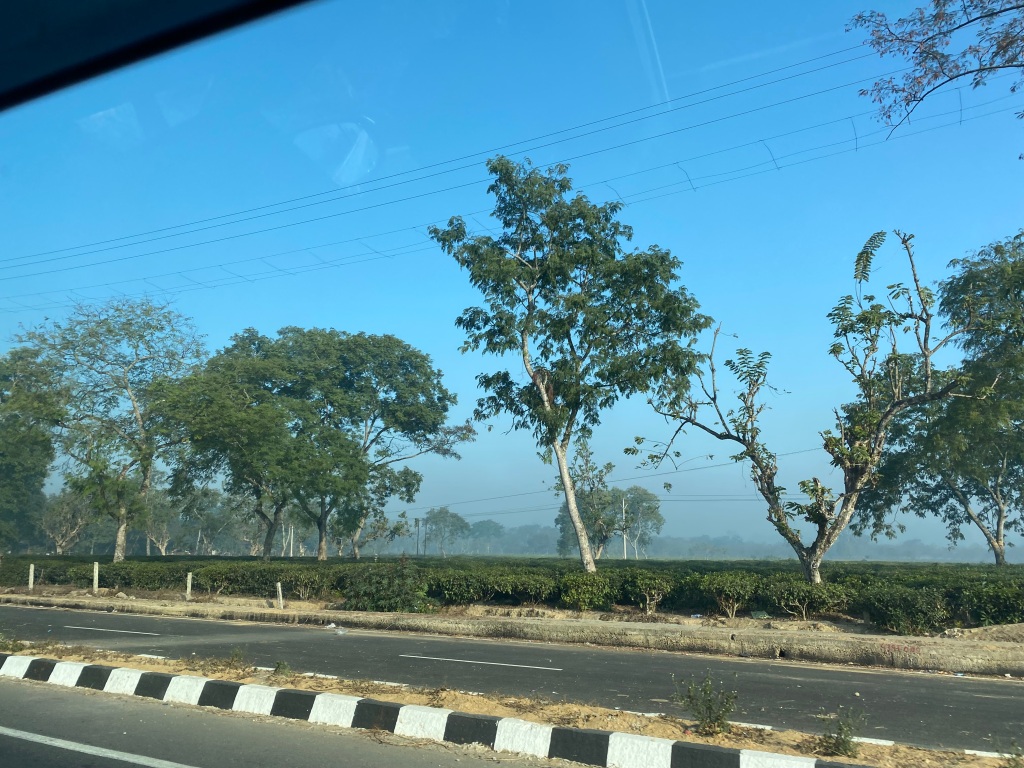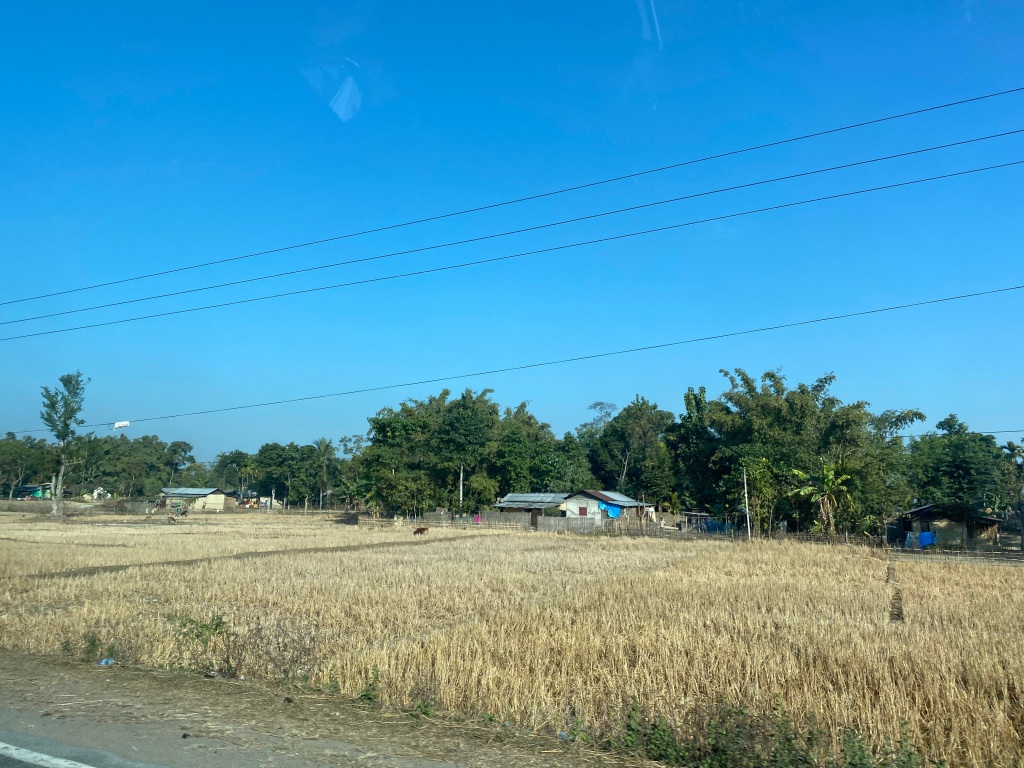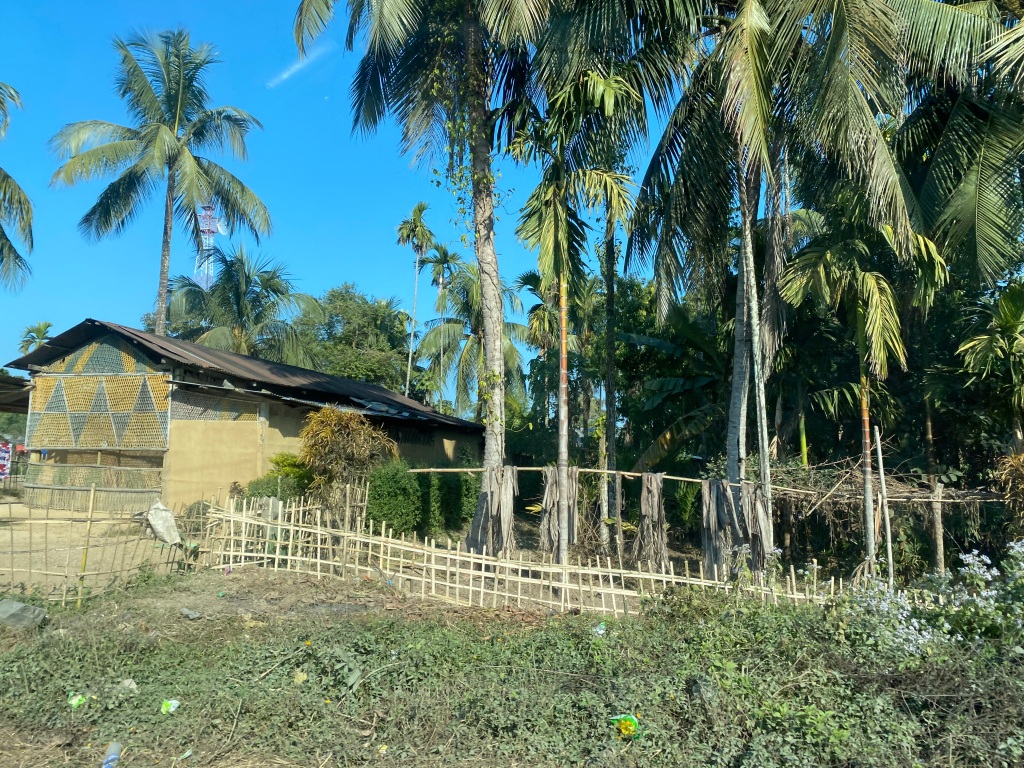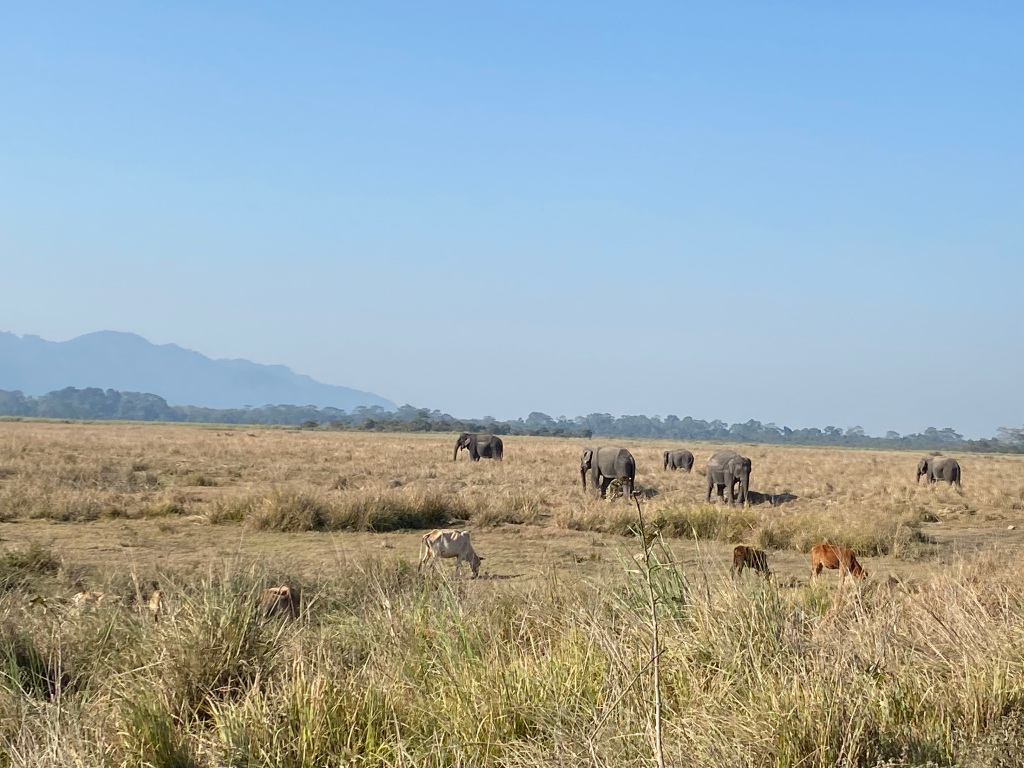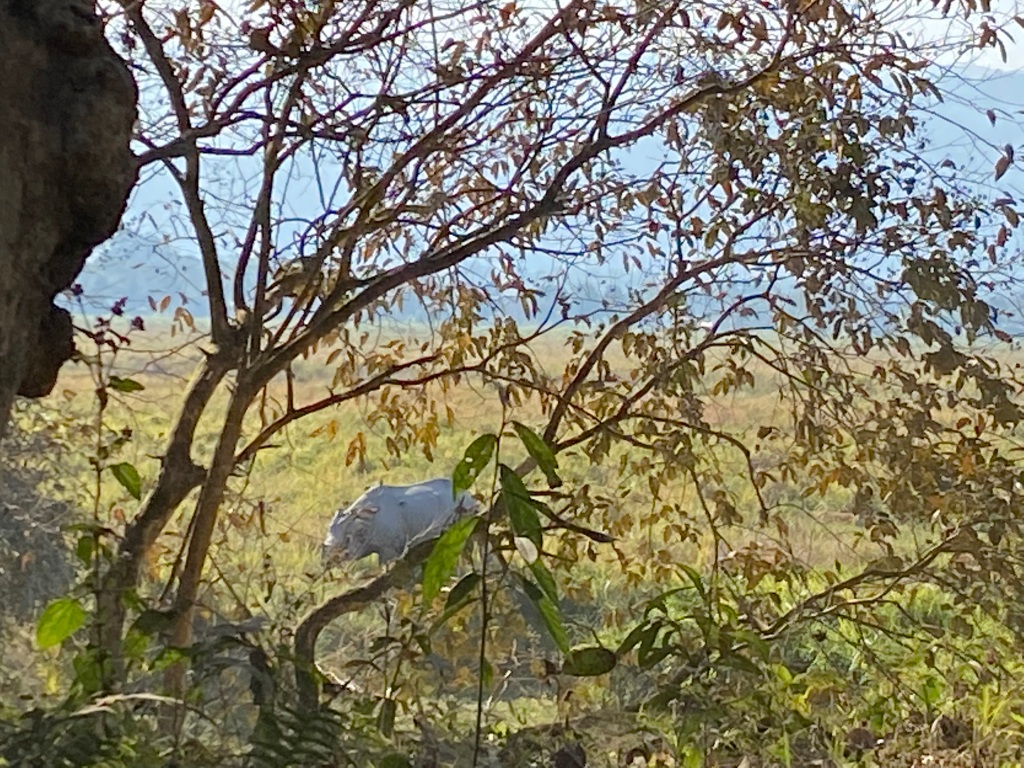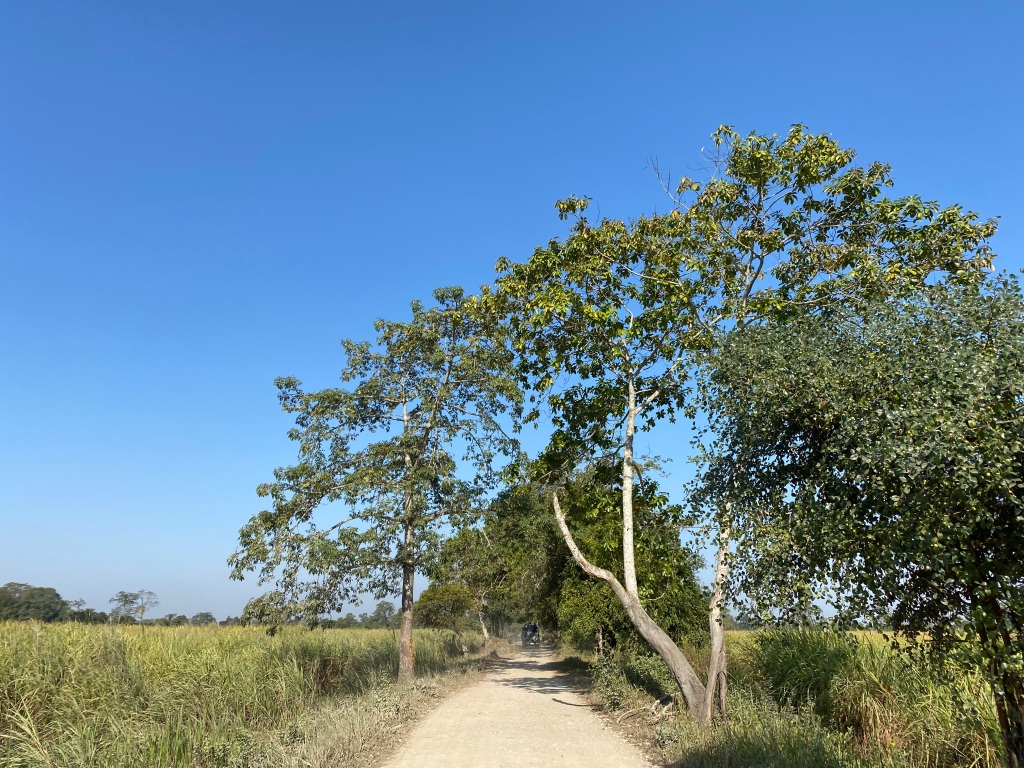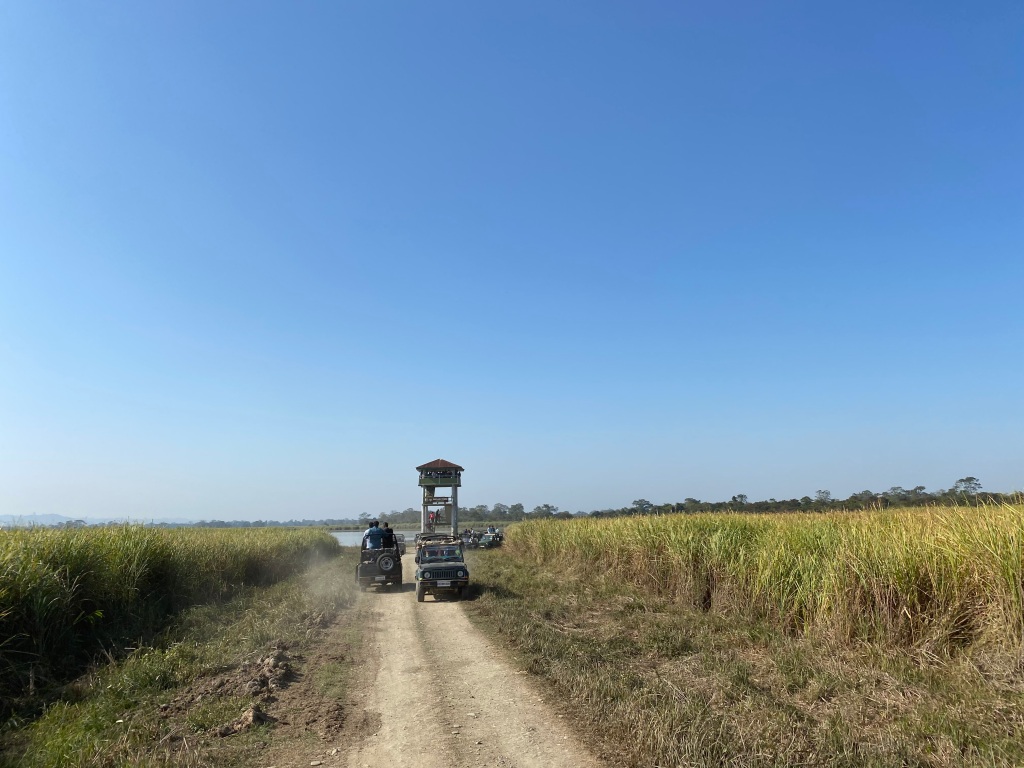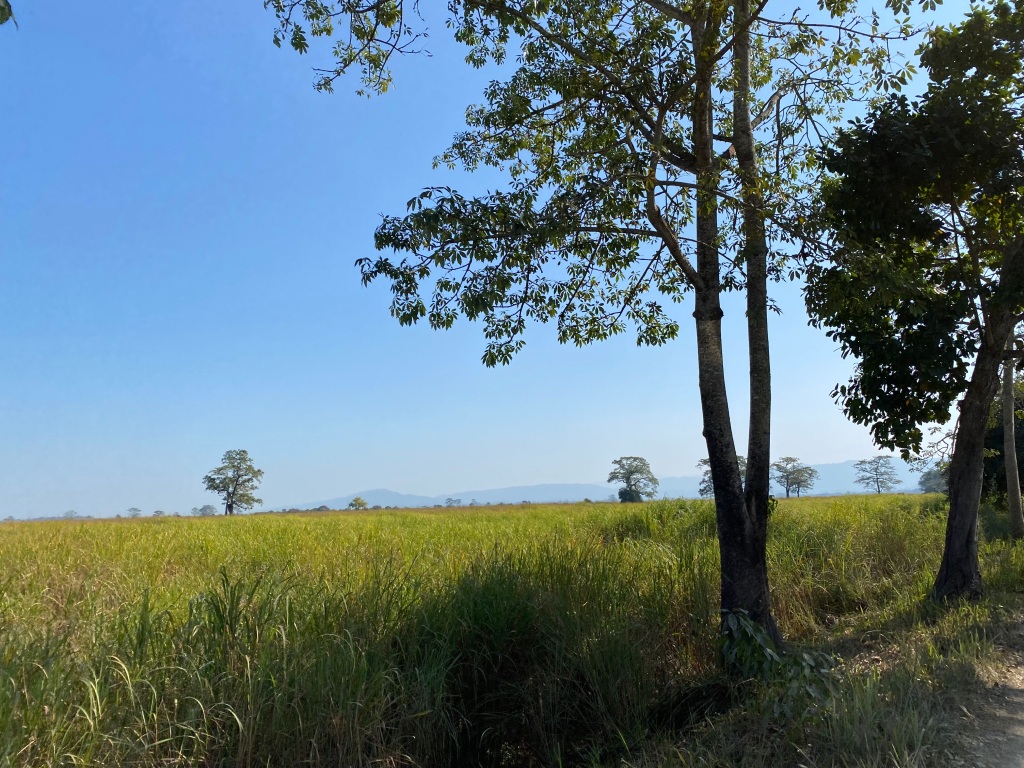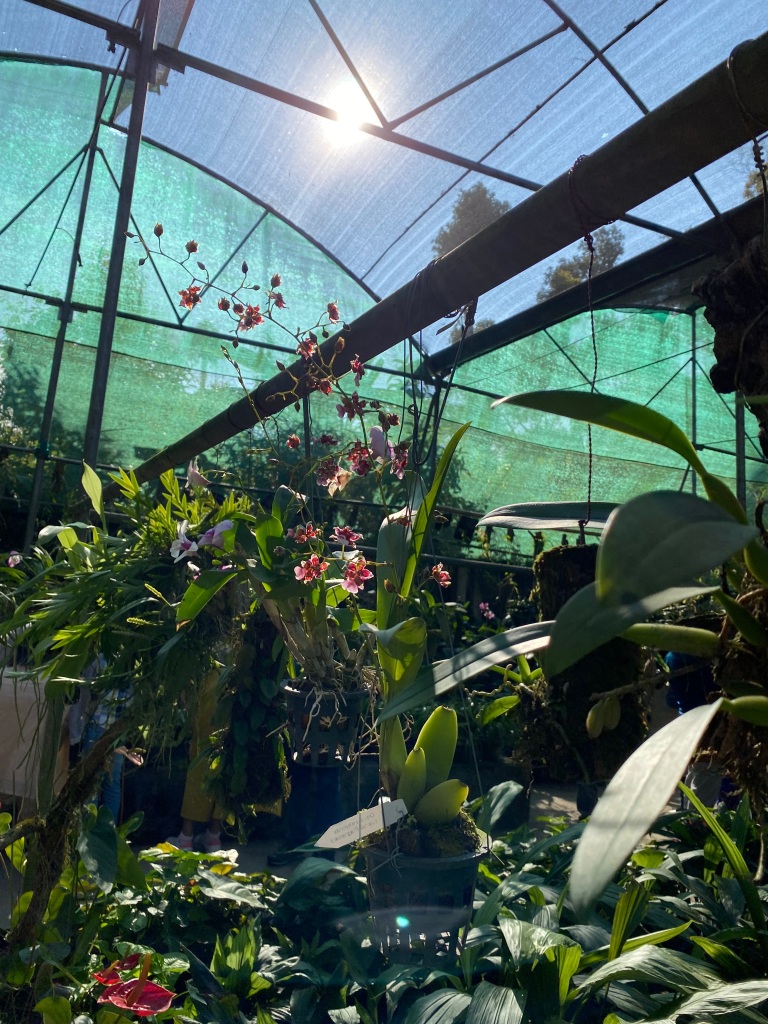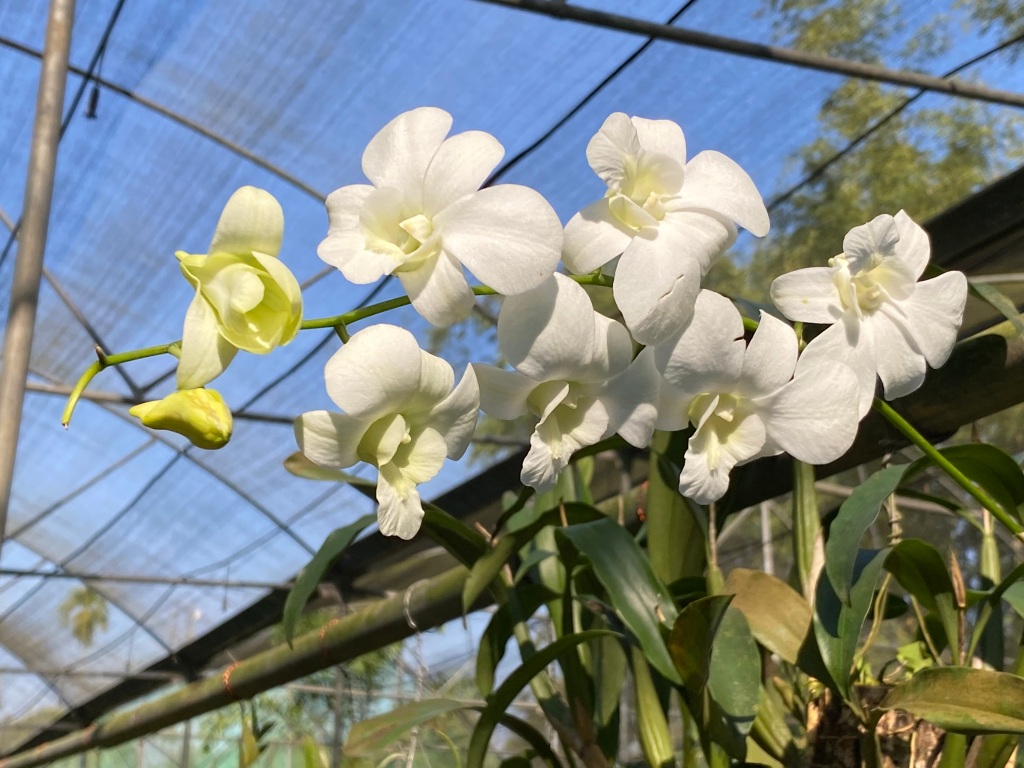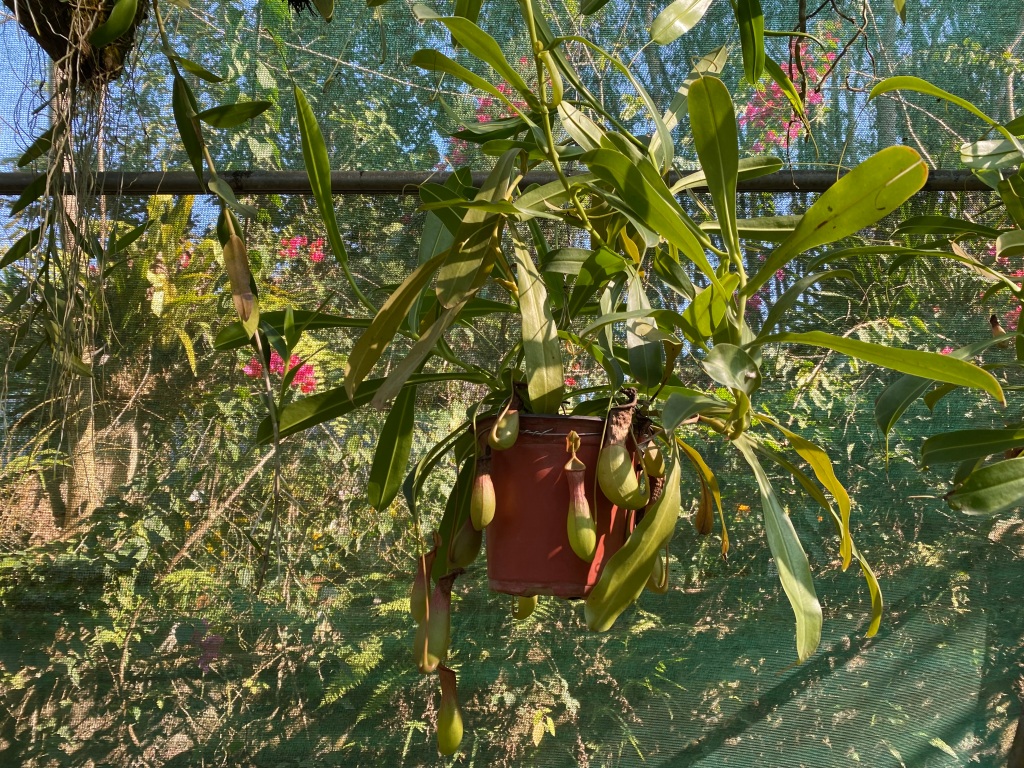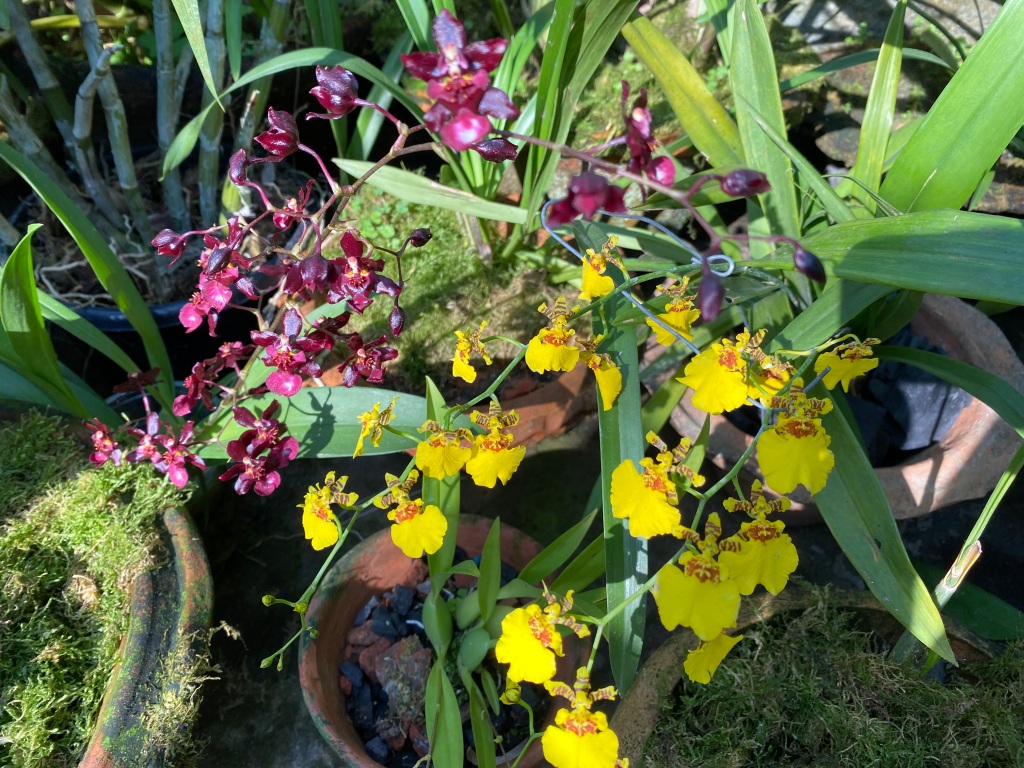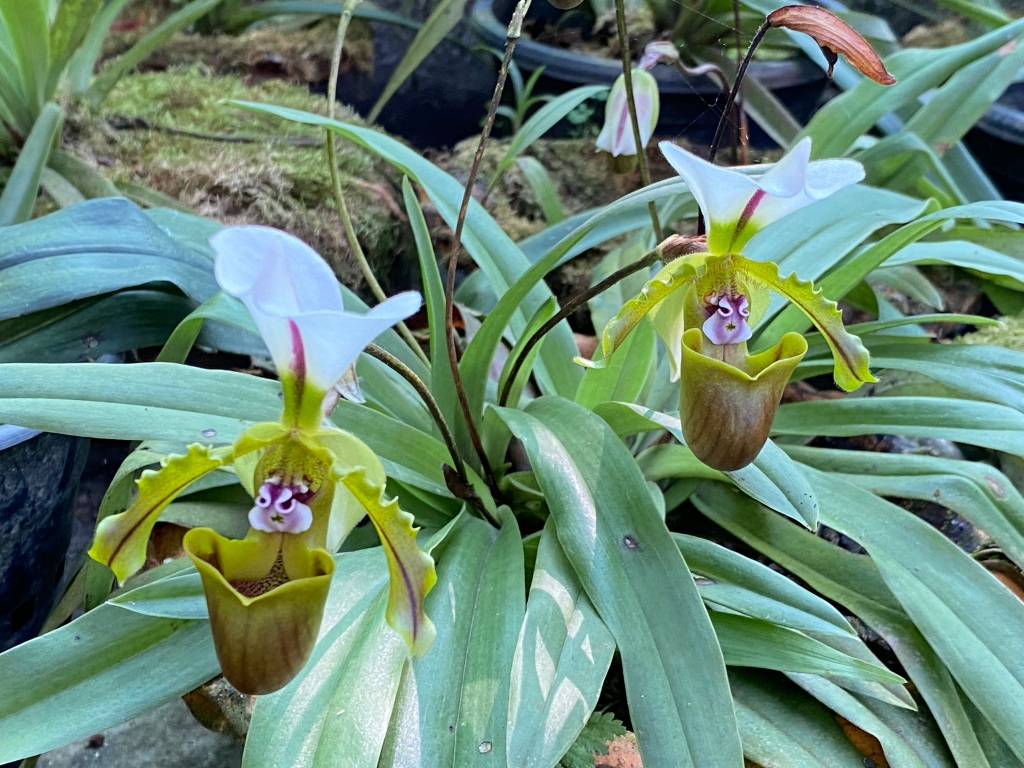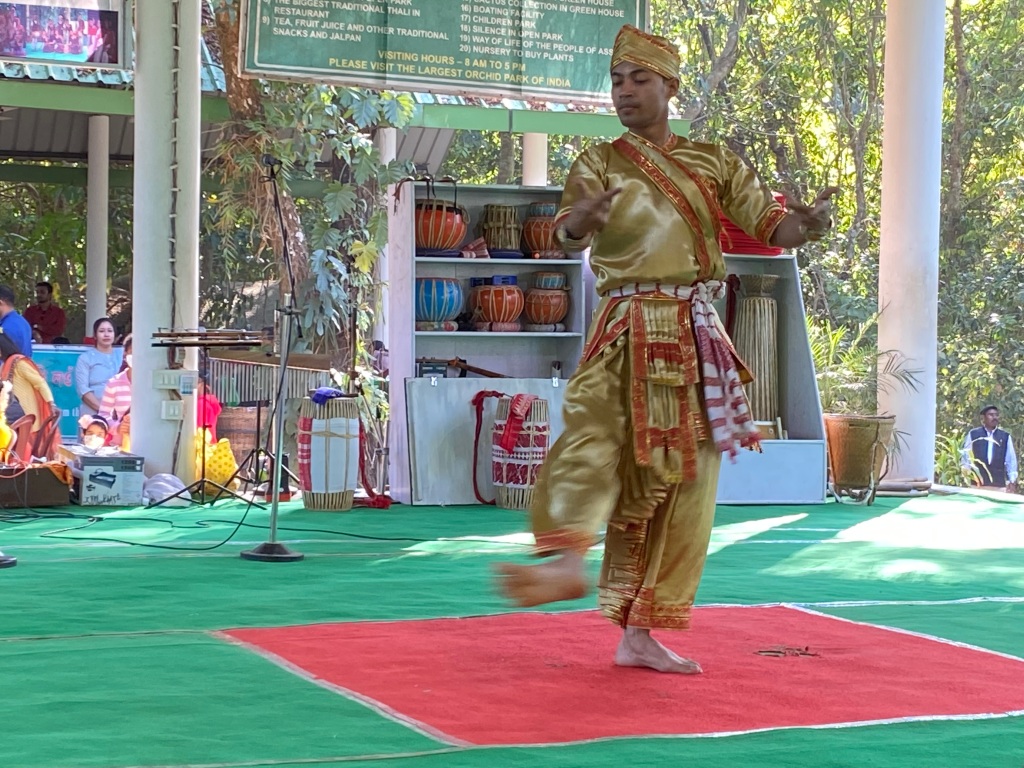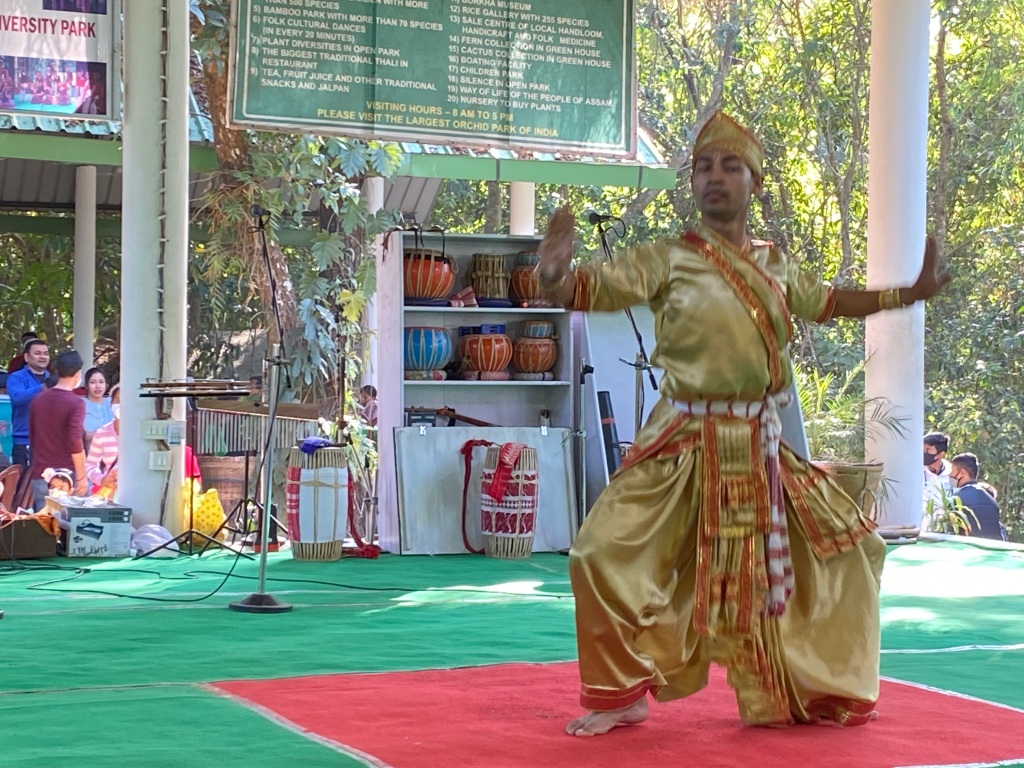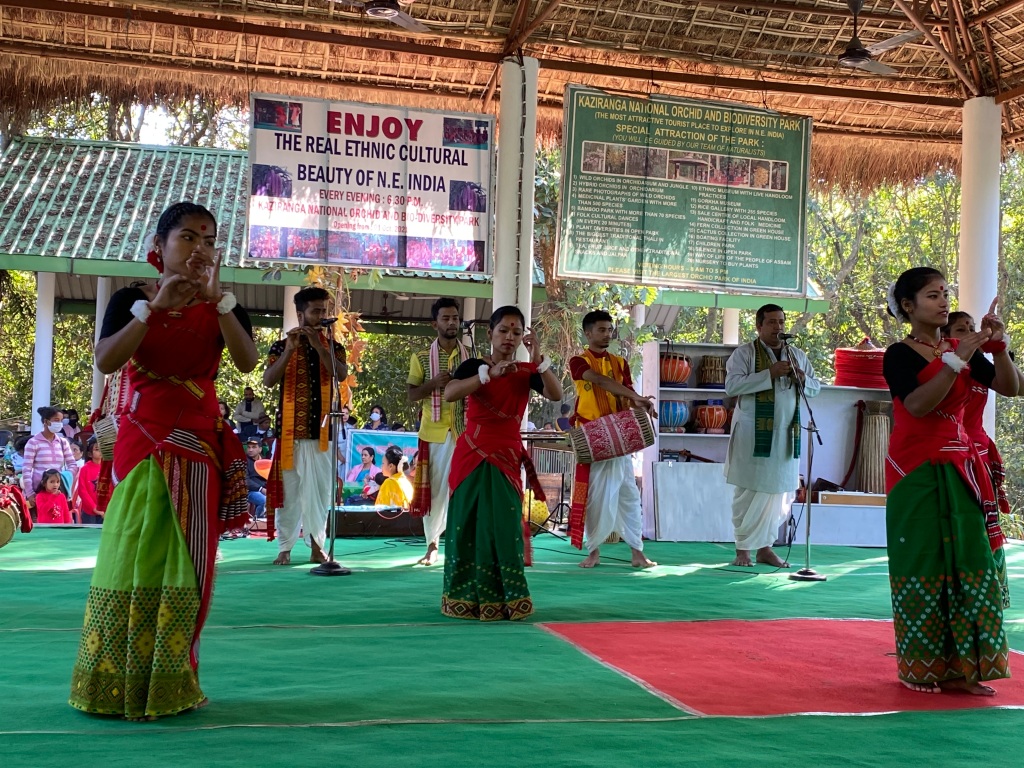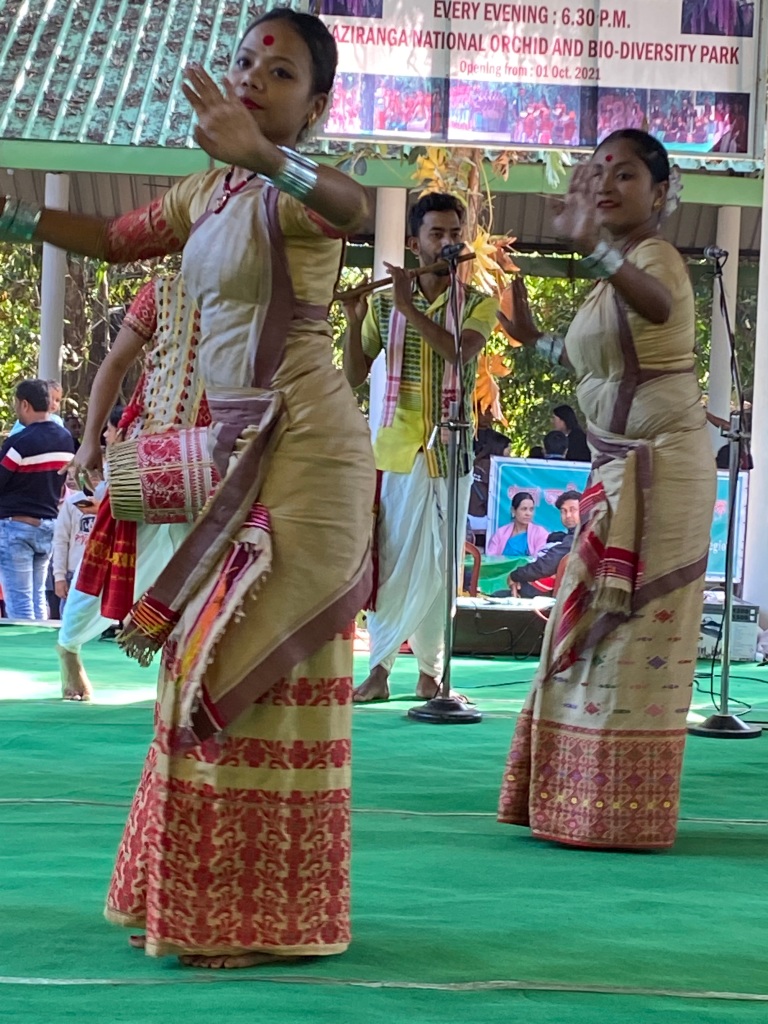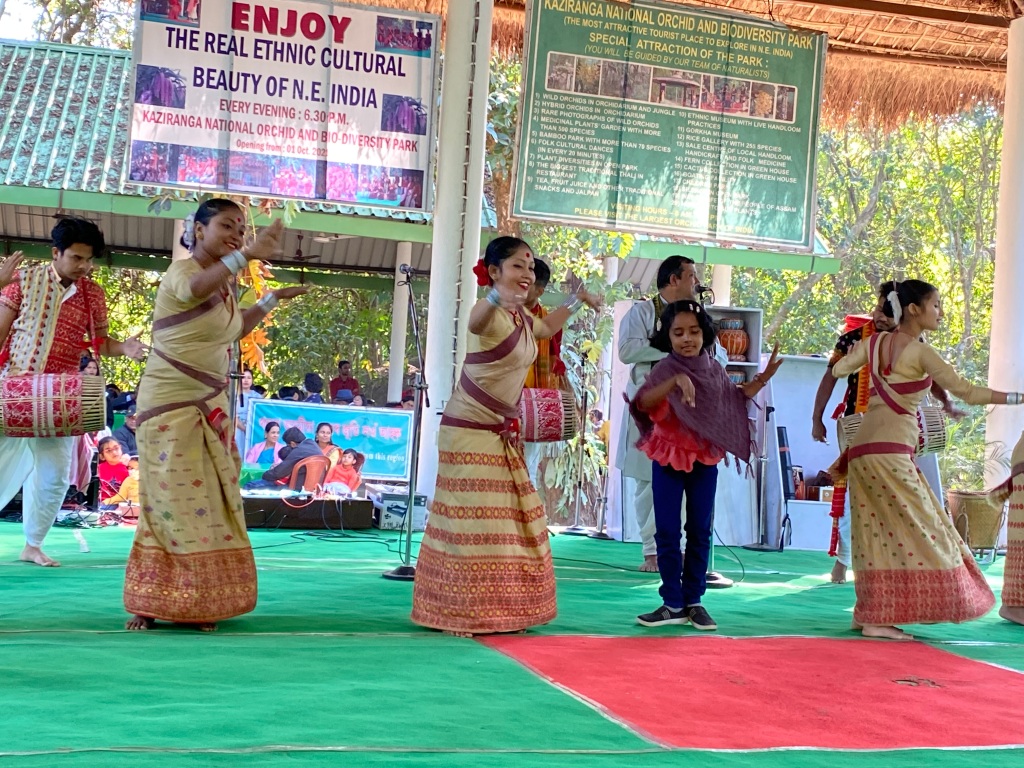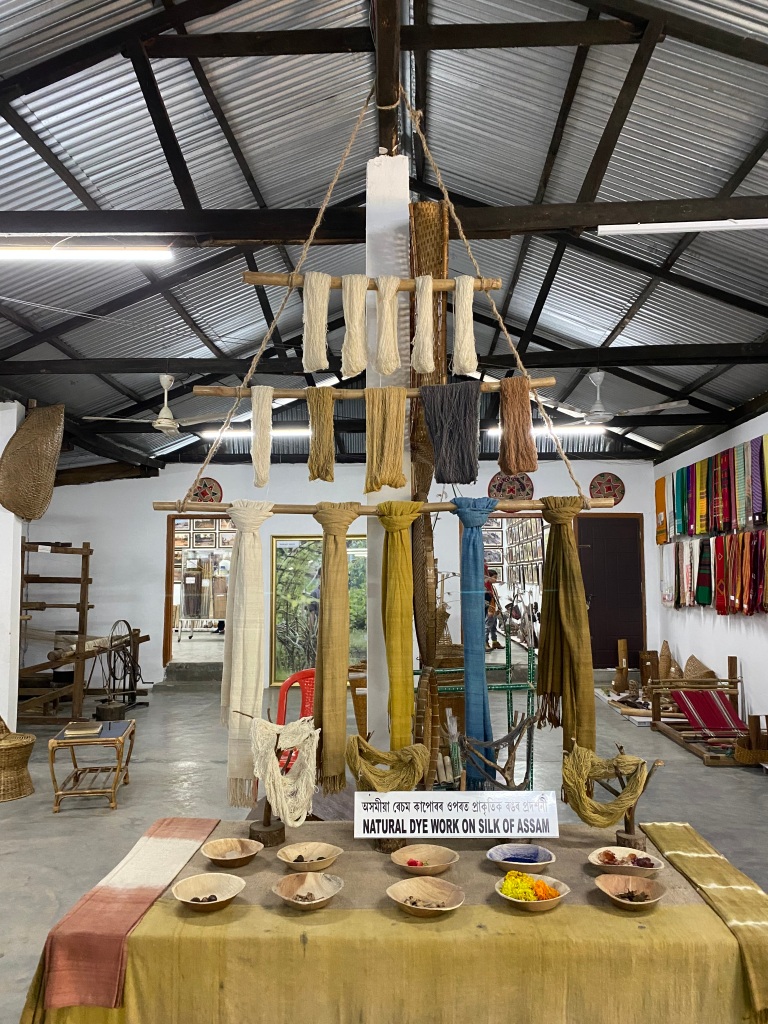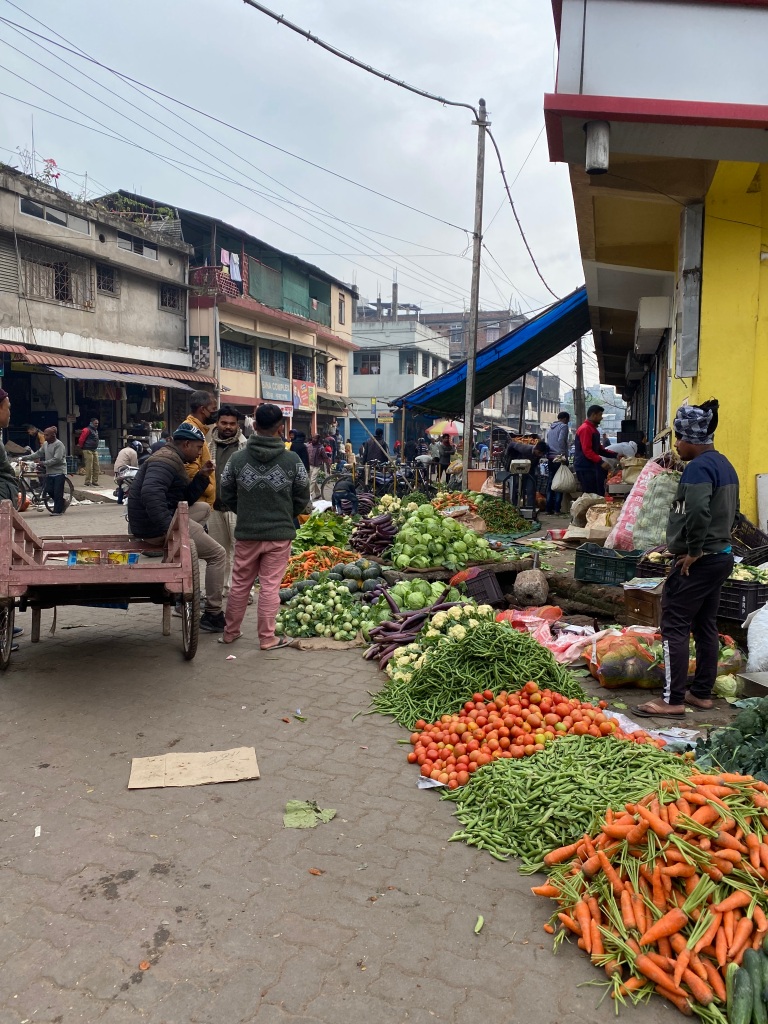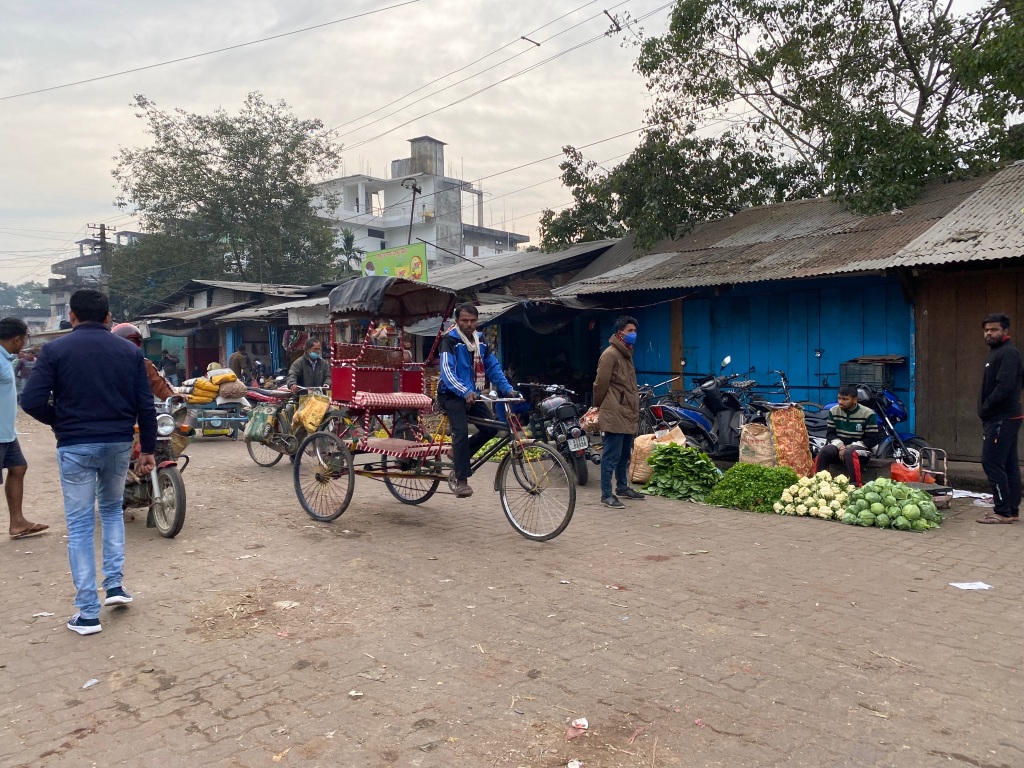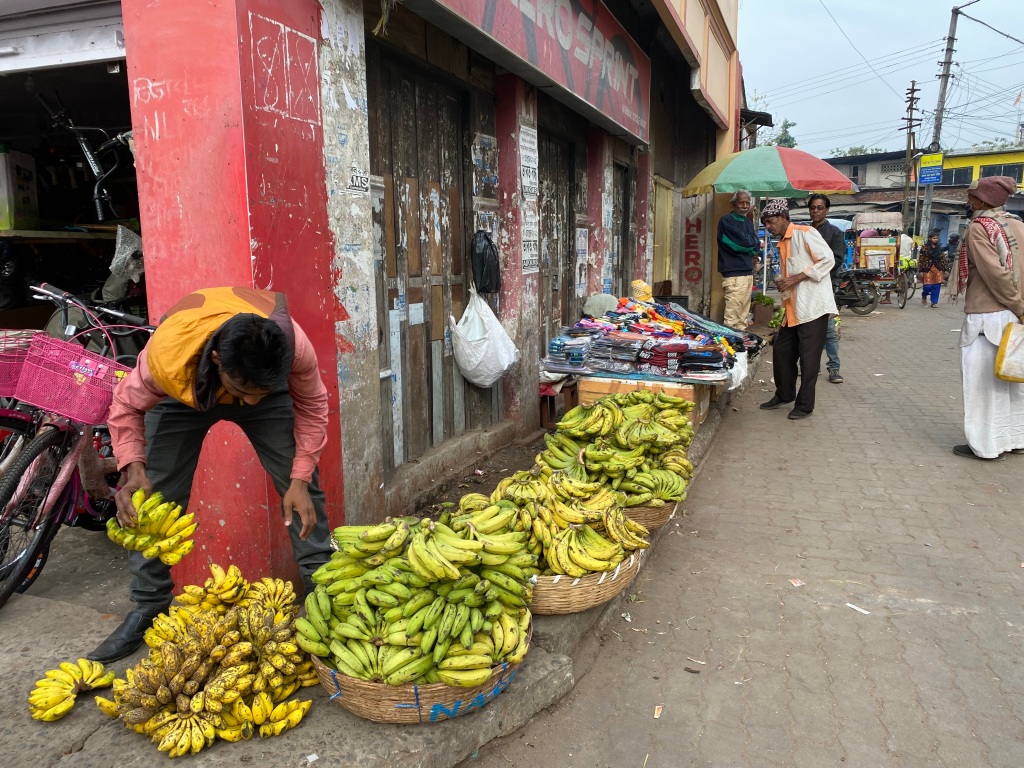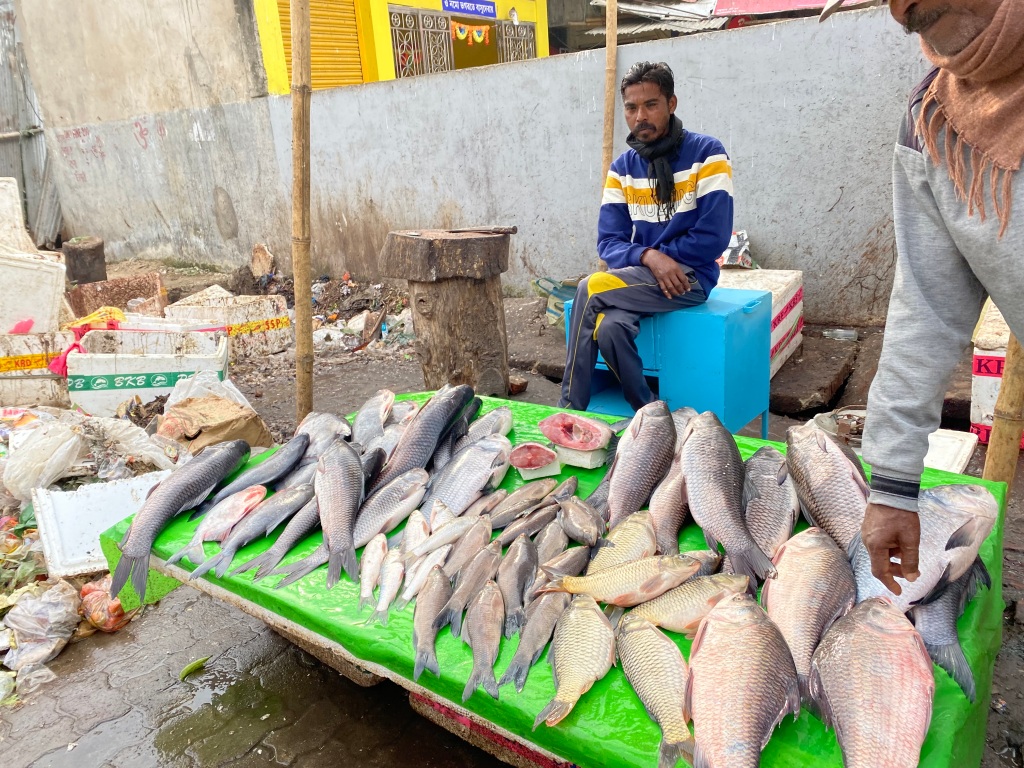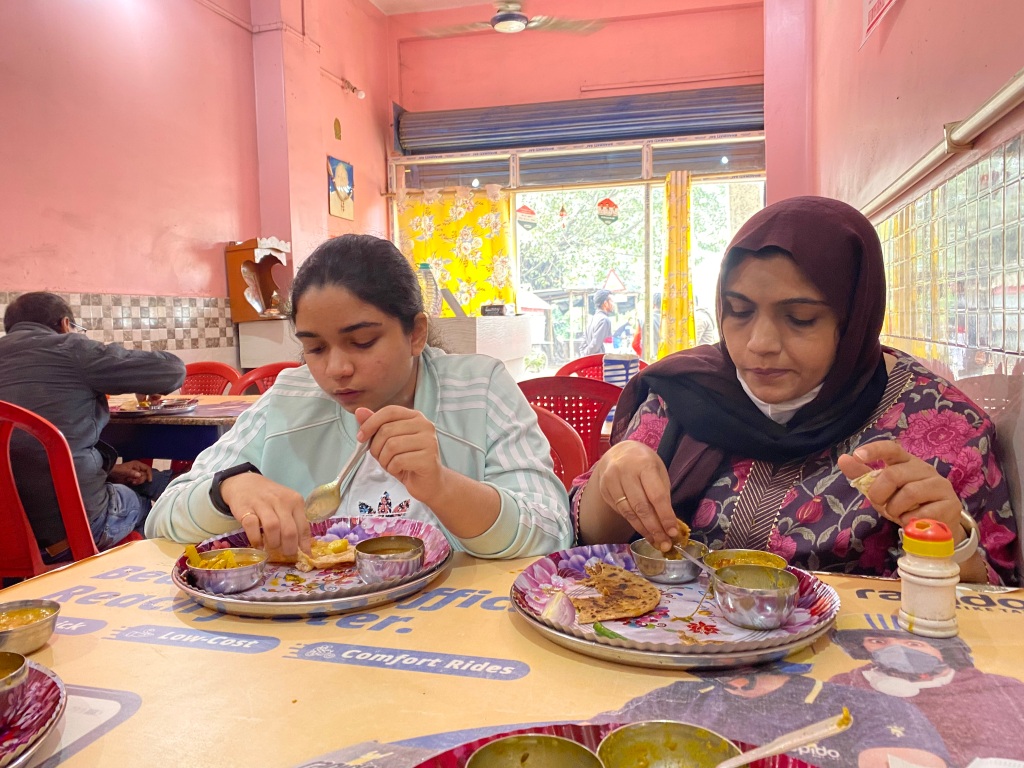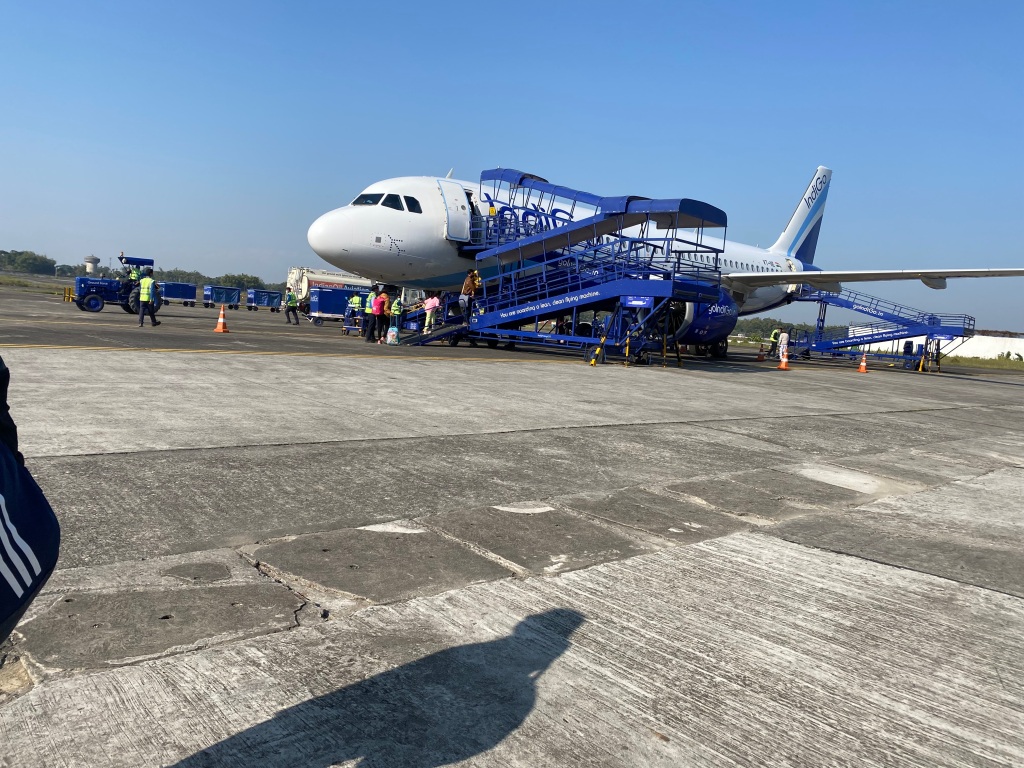I did not have to think twice before I said “Yes!” My sister invited me to tag along with her and her two daughters on their trip to visit her niece, who is a student at the National Institute of Design in Jorhat, Assam. I was in India with my husband to visit my family after having stayed away from them for an unusually long duration of 2 years due to the pandemic. Omicron had just emerged, and it was spreading quickly, and we had wavered in our decision to fly to India, but then eventually, we had stuck to our plans. We had already spent 2 busy weeks in Kerala, and my husband was winding up his stay. My plan was to stay a few more weeks in Kerala with my parents. This is the juncture at which my sister came up with her splendid idea for me. I was taken. And thus, on the day that my husband began his return journey to the US, I found myself in an Indigo flight with my sister, and my 2 lovely nieces, on our way to Jorhat via Kolkata (Calcutta).
I spent most of the 3 hour long flight in the middle seat, but I swapped seats with my niece just before landing which gave me an overview of the sprawling city that Kolkata is. Kolkata airport seemed old and busy, and crowded, without enough charging stations for our cell phones. The layover was an hour or so. The next leg was quick, about an hour to Jorhat. As we flew, I saw large swathes of barren land, interspersed with flowing river channels. Brahmaputra, I whispered to myself. It’s floodplains? We also saw what looked like a peak jutting over the clouds. Either we saw a snowy peak of the Himalayas, or our ignorance was taking us on a very fascinating ride. It was all good.
As we landed, we saw land wide and green, with trees scattered all over. As we closed in on Jorhat airport, it seemed very rural, and the buildings reminded me of modest and plain government buildings known for donning their yellows. We climbed down the stairs from the plane and walked to what was a tiny airport. “No photography allowed”, said a sign. The airport in Jorhat belongs to the defense forces in India, with just one civilian plane flying in and out every day. This must explain the very bureaucratic reception that awaited us, with 2 personnel checking for papers at the door, which we soon found out were proofs of vaccination. It was a very disorganized affair, and I found myself speaking in Hindi as seemed the norm there, and finding out to our dismay that my youngest niece (unvaccinated) would have to go through an on arrival Covid test in spite of her RT-PCR test showing negative infection from the day before. But we got it done without much difficulty at the makeshift location outside. The air was crisp and cool, and a formally arranged garden surrounded the driveway. Once we got the negative result, we walked to the exit, and taxi drivers approached us. With tourists written all over us, we knew we would have to put up with their pricing regardless of our own feelings about it.
Off to G K Palace, the hotel where my sister had made her bookings, 6 km away from the airport. We drove through dusty little roads and I thought the place had a familiar air to it, with plain concrete buildings and vegetation that included arecanut, plantain trees, and even coconut palms, but all with a dash of dust as one would see in certain towns in Tamil Nadu. What was different were the people, with their distinct facial features. And everyone seemed to be making much ado about the mildly cool weather, choosing to wear light winter jackets and shawls over their clothes.
The hotel rooms were clean, and the view outside was of a petrol station undergoing renovation, roads, railway tracks, sheet roofs on single story buildings, and a lot of vegetation in the distance. My sister’s niece, P, was soon with us, and the girls had their happy reunion, filled with chatter and laughter. We discussed our plans for the day, and then decided upon a visit to the NID campus where P is a student.
National Institute of Design at Jorhat enrolled its first batch of students in the year 2019, and P was one of those students. She is doing Industrial design there and was very eager to show us around. The campus has its main buildings connected by airy corridors with its bamboo columns and rafters. We went through the design studios, looked through projects P and her classmates were involved in, for example, a project that tries to make the lives of patients and bystanders better in a hospital, or the design of passenger amenities in a train. The cafeteria had posters of movies made by the Communications Design class. I heard from P that astrology is big in Jorhat. The students had made a movie based on a muslim astrologer and called it “Dua”. I was reminded of the huge billboard of an astrologer that I had seen earlier in the town. The walls of the cafeteria, with its colorful seats and tables, were painted by the communication design class with images that reminded me of illustrations in Dr Suess books. Walls came alive with much that was being said, all of it about food.
After visiting NID, we had a really nice dinner at Moti Mahal restaurant and then we got back to the hotel. P left for her campus, where a new year party was waiting her. The plan for the next day was to go to Majuli, a river island on the Brahmaputra, and known to be the largest river island in the world. The receptionist gave us the number of a taxi driver. My sister called him up to inquire about the fares. She also called the driver we had used at the airport. It took us a little bit of debating as to which driver we should pick, and finally, we stuck to the one the receptionist gave us. Pankaj would arrive by 8 in the morning. The ferries start operating by 8:30 am. The last ferry would leave by 3:30 pm from Majuli. To get most of the island without without being stuck there without a ferry to return, we had to leave early. The hotel had breakfast and dinner included in the room pricing, so we got ready early and left for breakfast. We were greeted by pitch darkness as we opened the door to what was supposed to be the restaurant. There was no one there! We went down to the reception and asked them what was going on. It was evident that the hotel was running low on guests as well as staff. We were asked to wait and since there was no other plan for breakfast, we waited. Half an hour or so later, pooris and a basic potato curry arrived as also some bread , butter and jam. After the tea, we were set to go. It was past 9 am by the time we got to Nimati ghat. The ticket counter wanted our names, ages as well as our phone numbers. We had heard about the accident that had happened a year back there, when a ferry overturned and 3 died. Assam government had brought many changes and taken over the ferry service after that accident. I am always concerned for safety when it comes to water journeys as I don’t swim. This was no exception. I assumed that they would need details of passengers in the event of an accident. Not a very comforting thought. The fare was just 75 rupees per person. Soon we were on the top deck of the boat. It was a misty kind of day. The water looked calm and expansive. The ferry did not have much of a crowd, and there were only a few others on the top deck. We took a lot of lovely pictures. P was still sleepy from the new year party and she would occasional snooze in a corner during the long journey. The ferry came to a halt near to a very sandy shore and stayed there for a long time. When we asked around, we found out that they were waiting for the fog to clear. It was 11 am by the time we got off the ferry at Kamalabari ghat. The taxi we arranged for was waiting and Narayan was our driver and guide for this stretch. He answered our polite questions as we set off for Auniati Satra, a Hindu monastery. I heard from Narayan that the river floods in the rainy season and the sandy road that we drove over ( about 2 kilometers long ) before we got to the tarred road would be flooded then. This explained the stilts we saw under the houses on both sides of the road, crudely made huts of concrete, bricks, and bamboo, with tin roofs. A curtain formed the entry door to all the houses. P told us that the kitchen formed the center of all the homes and often, people feel offended when students or tourists ask to be shown inside. She was reminding us in a way that it is important as a visitor to respect what is there, and in humility, to be aware of our own ignorance of their values and their sentiments. Poor as the region seemed to me, I was also enchanted by the sights of a new culture passing by me.
We arrived at the road leading up to the Auniati Satra. The street was lined on both sides with shops that carried a lot of knick knacks, including toys, jewelry, and food stuff. What stood out were the basket weave bags and all the shops had those. We removed our shoes at the gate to the Satra. As we walked on, we saw well maintained grounds, and passed by a spot where they grew the marigold flowers needed for puja. We came to the small temple or namghar as it is called there, and went inside, to see a huge prayer hall with some decorative columns and a couple of murals. There was a huge drum that my sister posed for a picture with. It was meant for the puja ceremony. I was surprised that we were allowed in the inner sanctum. I made a small donation, thinking that it was appropriate since we had not been charged an entrance fee, and we were almost intruding, for the fact that we were not devotees. The grounds around the temple had other buildings that housed the Satradhikar as well the students in training there. We met a couple of young students, one whose arm had been fractured. Birds were creating a cacophony in the canopy of the lush trees all around. We strolled around a bit and then decided to see the museum. There was a small entrance fee, and a few cultural artifacts inside a small room, nothing that aroused my curiosity. We politely looked around and then thanked the Museum keeper, and we walked back to the gate, got back into our shoes, and then began browsing through the small shops we had seen earlier. When I came to one shop, a very healthy looking, handsome young boy, who was the shopkeeper, struck a conversation with me. He asked me where we had come from, what language we spoke and then he asked me how I felt at the satra. I told him I liked the place a lot, and it was very peaceful (“bahut shanti hein idhar“). He was pleased to hear that. I asked him what his name was. Durlabh, he told me. He was a student whose family resided in a town called Dibrugarh. I bought a pair of copper bangles from him for 40 rupees.
We were very hungry as we left the Satra, and in a mood for some real Assamese food. Narayan drove us to a restaurant called Pulu. It looked like a tiny neat little restaurant as we entered. The tables had purple table covers, and the place was empty. The owner soon came up and took our order. We ordered 2 fish thalis and 3 vegetarian ones. As we waited, I used the restroom in one of their hotel rooms that they were preparing to let out. The room was a tacky little set up, with furniture taking up most of the space and very low ceiling. The bathroom was clean. We waited quite a while for the thalis to arrive. Instead of 2 fish thalis, he had brought us all fish thalis- 5 of them. We had also ordered fried fish. It was a terribly miscalculated affair, and we were to be utterly disappointed by the whole meal. The fish smelled like the pond it had come from. The fried fish was bone dry and some more. My sister and my nieces refused to eat the fish. P is one of those with a true travel spirit and told us how she ate fried critters in Nagaland. I am not that adventurous, but hated wasting a life. So, I ate the fish, but left the gravy out. All the other curries were simply bland. And the bill was exorbitant, more than three thousand rupees! I stood there doing calculations and found that he had charged us for an extra Thali. It came down a bit, but even then, it was like highway robbery. I asked him what Pulu meant. It was his son’s name. He told me how his staff were mostly gone, as it was New Year day and they had to attend the yearly fair (picnic as he called it) on the mainland. He asked us to leave a good review online. Just you wait! We joked about the whole thing as we set out to see the mask makers of Majuli. The name “pulu” should have been a red flag , we joked, since it is a slang for “a lie” in Malayalam. ” Now let’s just think we donated to little Pulu’s education fund,” I suggested. At least it keeps out the bitterness at being duped. The fishy affair is one to remember for life.
The mask makers were busy at work, applying and sculpting with cow-dung. P explained the construction of the masks to us. Bamboo strips are weaved together using very strong star knots, to form a skeletal framework for the masks, over which clay and cloth are pasted to form a solid surface. Over this, a mixture of clay and cow dung is applied that is sculpted to form the needed details on the masks. There was a big serpent like costume lying on the ground, and it began moving all of a sudden creating excitement for the people around and a kid soon emerged from the serpent. There were 2 buildings that formed the main center of their operations. They had masks and baskets on sale. The baskets were woven out of dried water hyacinth strands, and there was a good variety of them. My niece got one that looked like a cup and I got a cylindrical one with a thin stranded handle, which I thought would look lovely holding a money plant inside. Or dried flowers. We did not have a lot of time left to get to the ferry, and we hurried back to our vehicle, to head back to the ghat. The return journey saw us seated in the lower deck, with a room full of passengers. And surprise surprise, in a place where we seemed to be the only non-local visitors, we came across another muslim (I could see from the hijab) family who struck a conversation with us when when they heard us speaking Malayalam. And they were also in Jorhat because of NID, with a daughter studying there, whom, of course, P knew well. The boat was very crowded, and as we approached shore, we realized why. The new year picnic and fare that the Pulu staff had gone to was visible in full sway along the shore just before we got to the ghat. The ghat was crowded as well, and our taxi was delayed due to the traffic. The newest driver, Avinash, was very talkative, pointing out great restaurants and stores to us, and we asked him about Kaziranga National park and how much he would charge us for a trip there. His over enthusiasm made us uncomfortable, but then, it was also great that he was giving us so much information. After some light snacks at a small snack bar called Mithai junction, where we also had matka teas (tea in small earthen cups), we set off to the hotel, promising my younger niece, S, always the hungry one, that we would return later for momos (dumplings) from a vendor that P had recommended. And we did take a stroll through the town later to buy the momos. They were so burning hot and spicy that we were left in tears. We also bought some bread and cheese for making sandwiches in the morning to carry with us to Kaziranga. We planned to leave very early and we set it up with Avinash to be there at 7 am the next morning. The last jeep safaris at Kaziranga would leave by 9:30 am, and the drive to the national park would be 2 hour long.
Avinash arrived on time, but we ladies were not ready yet. The girls simply would not go by our advise to sleep early. And the hotel was simply not keeping its word on heated water. We had complained earlier at the reception, and had been assured that it would be fixed, but there still was no hot water in the bathrooms. And so, we had to heat water in the kettle to take a morning shower. Following all the hustle and bustle, we managed to get out by 7:30. We had to pick P from her campus on the way too. Finally, we were on our way. We passed through misty tea gardens, with lone trees scattered here and there, and then a lot of rural landscapes, little towns, and by 9, we were at the national park. The rest room trip was arduous, even though they were pay and use toilets. There was quite a crowd too. Somehow, we stood out in the crowd. Most people seemed like they were from the north east regions. We went to pay for the jeep safari, and we were assigned a driver from the lot who were standing there and waiting for customers. When I saw our jeep, I was disappointed because it seemed old and broken. I sat in the front and then there were two more rows behind, that the others occupied in twos. As we entered the forest, we saw how the rest of the jeeps looked much better and had better seats. I felt almost as if I was in a pit. The others asked me to move back, even though it would mean that the three girls would be tightly packed in the back row. The two rows in the back were higher and I could see everything better there. Soon we realized that the real fun was to stand up. The air was beautiful, cool, fresh, clean, and the green grasslands were quite e feast for our eyes. We passed by elephants grazing, they were the tamed elephants that takes people on early morning safari into the grasslands. We got a sight of one rhino grazing about 200 feet away. As we went deeper into the park, we drove through beautiful trees, lakes and more grasslands. It was just a delightful ride. The girls were now standing up on the seat and giggling all along. For me, who is used to traveling with boys, it was quite a change to be with three girls. I enjoyed their laughter and their delight at just being together. The safari was about 2 hours long. We did see a few animals, a large reptile (our jeep driver was not really imparting any information to us and there was a language barrier), turtles, deers, a lot of birds, wild buffaloes, and another lone rhino. But it was not much, and I really came away feeling that to see the animals, one has to take one of the earliest safaris. Elephant safari would be the best for those that have the courage to do it.
Once we came out of the park, we were dropped at a spot with many handicraft shops and tea stalls. Avinash was there, waiting for us. We had some excellent tea there. The cups are tiny in Assam. But the tea is generally very good. I bought a handbag made from handloom fabric with a very traditional print of red, black and white. I also picked a wooden rhino from the massive collection of wooden animals. Our next stop was the Orchid park, an ecological and cultural centre, with many exhibits including a green house full of a wide variety of orchids. P told us that the best season to visit is April, when a lot more orchids are in bloom. The climate in Assam and, I would think, generally the north east states in India, offer a great climate for orchids. We were there on a new year weekend, and it was unbelievably crowded there. The cultural museum was next, where we got to see various artifacts from Assamese culture. There was also a gallery of pictures of historic buildings from the region. Ahom kings are much respected in Assam, having ruled for 600 years, and we were given a brief history of their rule by a volunteer. We were told that they resisted Muslims too (the Mughals). That was the only hint of communalism I ever experienced during the whole trip. The Ahom kings originated in a region of China, but later migrated to the south east (Thailand) and from there, arrived in what is now Assam. I asked them what they were doing traveling so much. “Bas ghoomne key liye aye,” she told me, which means that they were only wandering! History is but an interpretation, I thought. The kings did rule well, I assume, since they ruled for such a long time. After this, we sat down at the venue where artists perform the various folk dances from Assam, including the Bihu dance that we have often heard about and even seen at school events in our childhood. The north east region has many tribes who have their own traditional culture and art forms. Some of these dance forms were part of their agricultural practices. Another important aspect of their culture is weaving. Every home would have a loom. It played a part in romance too, where the expression of love was through weaving a particular kind of design for your Romeo (or Juliet, but I guess women did the weaving!) and then gifting it to him. Thanks P, for that trivia.
We checked out the dining area next to see if we could eat an Assamese thali there, since the place is well known for it. But again, the crowd of people waiting to eat deterred us and we gave up. We were also very tired. As we got out, we wandered along the shops, had some snacks, bought a few more handicrafts, including two beautiful handloom shawls in the traditional Assamese colors (red and black over cream). I did not find a good set of mekhela-chador, the traditional dress worn by Assamese women, even though I really wished to buy one. Now it was time to set back. The girls and the adults could not come to an agreement on what to eat, and going by the experience of the day before, we decided it was best to eat once we got back to Jorhat. The drive was long, and my niece was showing signs of illness, sneezing and complaining of irritability in her throat. Omicron is on everyone’s mind. Avinash, the driver, advised us to make sure she looked better at the airport, so she is not sneezy and coughing there. It could set set off alarm bells, and she could be asked to take a test. Not a desirable scenario, but it was not in our hands. We got off once we got to Jorhat town and walked to Food villa, a restaurant nearby. The food was great, after which we shopped at a store selling Assam tea, from where we bought quite a lot of tea. Assam red tea is quite famous, it is also called Orthodox tea for some reason. After the shopping, it was time to retire. Except now my niece was really irritable from her cold and cough. Poor thing had a terrible night, and so did my sister and I, accommodating to her needs. Children!
Our flight to Kolkata was at 1:30 pm the next day, and we had enough time in the morning to go to the vegetable market. My niece, S wanted to buy the small potatoes about which she had heard from Avinash. The vegetables were a pure delight to see. The fish vendor had very unusual kind of fishes, some swimming around in shallow tubs of water. We chatted a bit with the fish vendors and heard from them that they had fishes called Ari, Rohu etc. As we walked further, we saw the heap of local bananas and remarked in Malayalam that it did not look great, “nallathalla“, when the vendor shouted back at us, “nalla pazham” meaning “good bananas”. We were surprised to hear our language there, even though we should not have been, when our father employs an Assamese guy to do farm work for him. Our fruit vendor told us that he used to work in Ernakulam for a while and was there during the entire length of the complete lockdown in the first wave of the pandemic. After that, he decided to return home. We bought some bananas from him, and wished him well.
We were the only women in the market, but somehow, we did not realize it then. Jorhat has been a great experience traveling as a group of women. The town seemed like a safe place, and I was told by P that the town is a very laid back place with people closing down shops by 8 pm to go home and spend time with their families. I saw girls traveling in group autos, and was surprised to see a school girl riding along with the driver in the front seat, a common practice there. P loves the town and is genuinely at home there. She recounted to us her tryst with Covid while in Jorhat, her days being treated at the hospital, all so far away from her home. I imagine that these experiences had strengthened her bonds with Jorhat rather than make her fearful of the place. She had been a wonderful guide on our short trip to Assam. After a simple breakfast at a small restaurant near G K Palace (how I wish I had noted the name!), of puris, also parathas and vegetable curries, it was time for us to go back. On the way back, we spent 5 hours in Calcutta airport and had some good food there. I love the food courts in India, offering such variety of tasty options. The momos from “Wow! Momo” were quite a treat. There was also a great handicraft store called Biswa Bengla, where we saw cotton handloom sarees worth 75,000 rupees. It was a very pricey store, but the merchandise were pure works of art. As usual, my sister fished out some beautiful sarees to gift that were not so exorbitantly priced. I bought a couple of shawls again!
We got back to my sister’s house late at night. It was a delightful time in Assam, and I wish to go back. I would plan a bit more next time. But that does not mean that lack of planning made for a bad trip. It was a “make it up as you go” kind of trip. And the fact that we were all women let us do all the girl stuff- a lot of chatter, giggles, shopping, food and a lot of strolling down the streets. I would say “yes” all over again.

